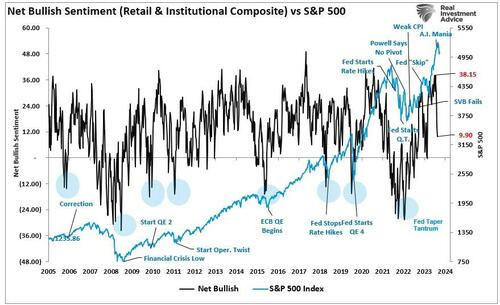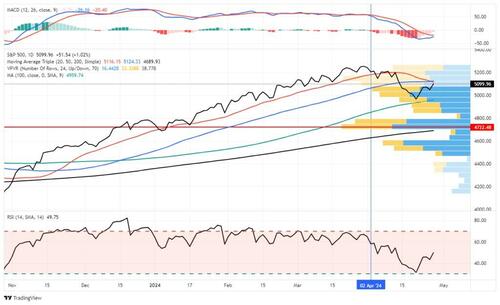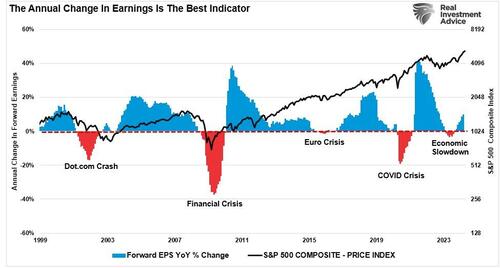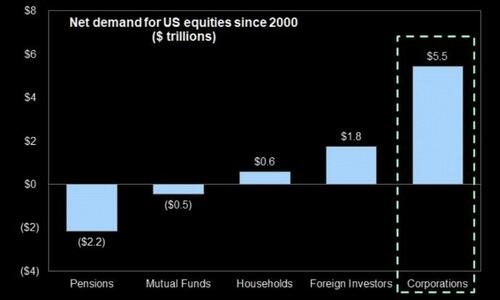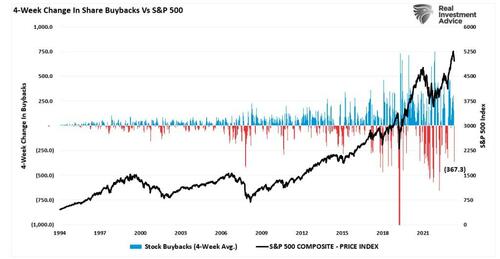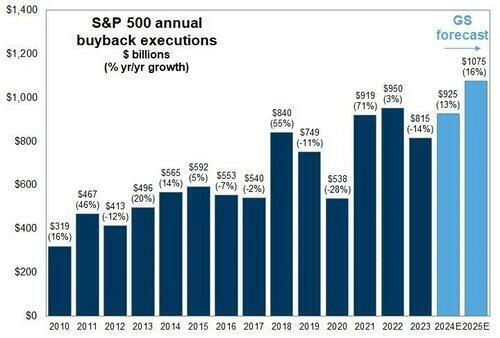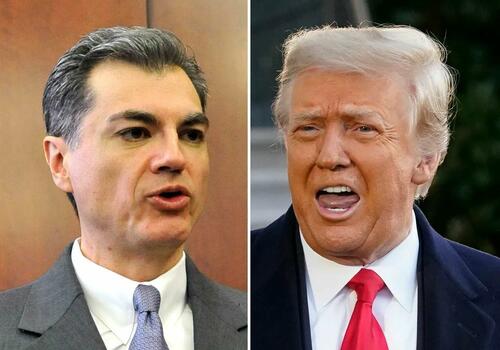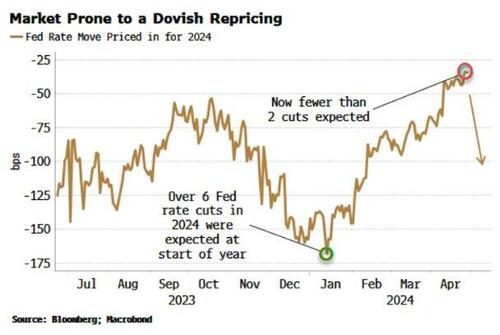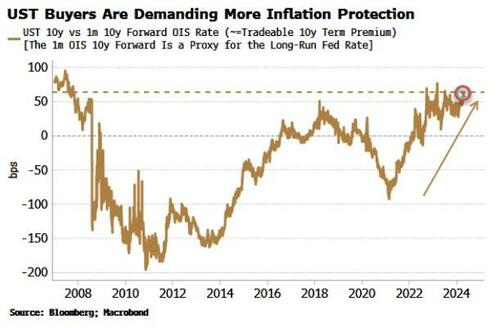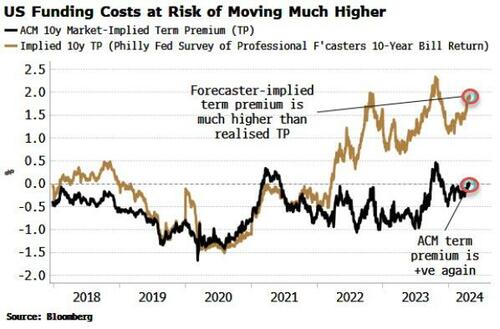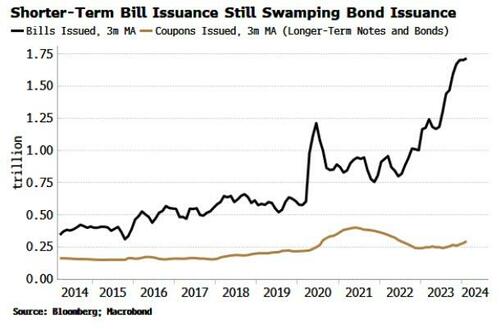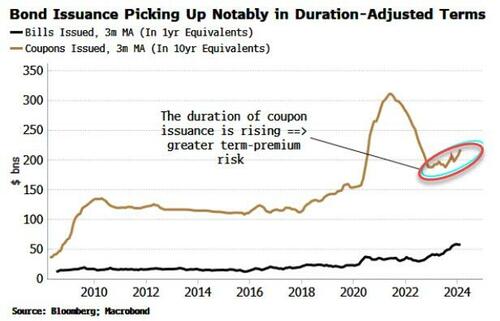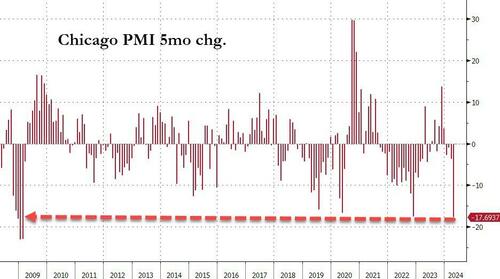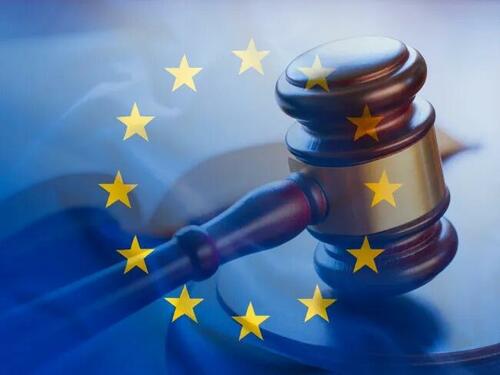To live without faith, without a patrimony to defend, without a steady struggle for truth – that is not living, but existing.
Distinction Matter - Subscribed Feeds
-
Site: Zero HedgeBullish Sentiment Index Reverses With Buybacks ResumingTyler Durden Tue, 04/30/2024 - 13:25
Authored by Lance Roberts via RealInvestmentAdvice.com,
Over the last two weeks, the bullish sentiment index has reversed from extreme greed to fear. The composite net bullish sentiment index, comprised of professional and retail investors, fell from 38.15 to 9.9 in two weeks. The previous drop between July and October last year was similar and marked the bottom of the correction.
While the bullish sentiment index can indeed fall further, what is notable is the sharp reversal of market “exuberance” in such a short span. However, as discussed in “Just A Correction,” there was a significant gap between buyers and sellers.
“However, at some point, for whatever reason, this dynamic will change. Buyers will become more scarce as they refuse to pay a higher price. When sellers realize the change, they will rush to sell to a diminishing pool of buyers. Eventually, sellers will begin to “panic sell” as buyers evaporate and prices plunge.”
Like clockwork, that correction came quickly, with the market finding initial support at the 100-DMA. With solid earnings from GOOG and MSFT, the market rallied to initial resistance at the convergence of the 20- and 50-DMA. It would be unsurprising if the market failed this initial resistance test and ultimately retested the 100-DMA soon. Such a pullback would solidify that support and complete the reversal of the bullish sentiment index.
“Whatever trigger causes a reversal in the bullish signals, we will act accordingly to reduce risk and rebalance exposures. But one thing is sure: investor sentiment is extremely bullish, which has almost always been a good “bearish signal” to be more cautious.
While we have warned of a potential correction over the past few weeks, it reminds us much of June and July last year, where similar warnings for a 10% correction went unheeded. We are now seeing many individuals ‘jumping into the pool’ in some of the most speculative areas of the market. Such is usually a sign we are closer to a market peak than not. As such, we want to make adjustments before the correction comes.”
Very quickly, as supported by the bullish sentiment index, those bulls are turning bearish and are now calling for a more profound decline.
While such is possible, I suspect most of this correction is complete for two reasons.
Earnings Continue To Remain Strong
The first reason is that despite higher interest rates, earnings growth continues to remain robust, at least among the “Magnificent 7,” where Google (GOOG) and Microsoft (MSFT), in particular, exceeded estimates by a wide margin. However, overall, and most importantly, earnings growth has continued since the October lows of 2022. Notably, the support for improving earnings comes from the increased fiscal policies such as the Inflation Reduction Act and CHIPS Act.
While those policies will eventually fade, making forward estimates subject to downward revisions, the current earnings environment remains relatively robust. Furthermore, forward estimates remain optimistic that the Federal Reserve will cut rates later this year, lowering borrowing costs and supporting economic activity.
Notably, the increase in earnings, at least for now, remains a strong indicator of rising asset prices. The risk of a deeper market correction (greater than 10%) is significantly reduced during previous periods of improving earnings. While such does not mean a deeper correction can not happen, historically, corrections between 5% and 10% in an earnings growth environment tend to be buying opportunities and limit deeper reversal in the bullish sentiment index.
Improving earnings also precedes improving CEO confidence, which has provided pivotal support to financial markets since 2000.
Buybacks Returning
We discussed the most critical reason we expected a market correction in mid-March. To wit:
“Notably, since 2009, and accelerating starting in 2012, the percentage change in buybacks has far outstripped the increase in asset prices. As we will discuss, it is more than just a casual correlation, and the upcoming blackout window may be more critical to the rally than many think.” – March 19, 2024
Furthermore, the “blackout” of corporate buybacks coincided with more extreme readings in the bullish sentiment index. Buybacks are crucial to the market because corporations have accounted for roughly 100% of net equity purchases over the last two decades.
Here is the math of net flows if you don’t believe the chart:
-
Pensions and Mutual Funds = (-$2.7 Trillion)
-
Households and Foreign Investors = +$2.4 Trillion
-
Sub Total = (-$0.3 T)
-
-
Corporations (Buybacks) = $5.5T
-
Net Total = $5.2 Trillion = Or 100% of all equities purchased
-
Unsurprisingly, that blackout window coincided with a sharp contraction of more than $367 billion in buybacks over the last 4-weeks. Consequently, when you remove a critical “buyer” from the market, the ensuing correction is unsurprising.
However, corporate share buybacks will resume in the next couple of weeks, and with more than $1 trillion slated for 2024, many buybacks remain to complete. Such is particularly the case with Google adding another $70 billion to that total.
As noted above, improving earnings and a decent outlook for the rest of this year also boost CEO confidence. (If you don’t understand why buybacks benefit insiders and not shareholders, read this.)
With robust economic activity supporting earnings growth, that improvement boosts CEO confidence. As CEOs are more confident about their business, they accelerate share buybacks to increase executive compensation.
The liquidity boost from buybacks and stronger earnings will likely provide a floor below the market. This doesn’t mean the current correction doesn’t have more work to do. However, it is unlikely that it will resolve into something more significant.
At least for now.
-
-
Site: Zero HedgeYour Tax Dollars At Work: US To Buy Ukrainian-Made Weapons For UkraineTyler Durden Tue, 04/30/2024 - 13:05
It's not just US and Western defense contractors and arms makers that have been raking in the billions as a result of Washington's mammoth defense aid handed over to Ukraine, but Ukrainian defense companies are also enjoying the largesse at US taxpayers' expense.
"A total of $1.6 billion of the recent US aid to Ukraine would go to the purchase of Ukraine-made weapons, said a senior Kyiv official," Defense Post reports of the $61 billion in US aid just approved.
 Image via Reuters
Image via Reuters
G7 countries have been planning broader assistance to Ukraine which would develop and prop up a Ukrainian domestic military-industrial complex for the long-term, in order to ensure the country's independence from Russia well into the future.
Ukraine parliamentarian and foreign policy committee member Arseniy Pushkarenko has said, "This is very important today, because it is about the creation of joint defense enterprises that will be located on the territory of Ukraine or in neighboring countries, taking into account security aspects."
The funds will be taken from the $14 billion apportioned by Congress for the Ukraine Security Assistance Initiative (USAI), allowing the DoD to purchase new weapons for Ukraine.
Interestingly, Pushkarenko admitted that all of this is about more than just defending Ukraine from the Russian military onslaught, but is also about 'testing' new weapons systems in real combat.
"This is one of the factors in the development of the Ukrainian economy. Today, the military technologies that we have are tested in combat conditions, which makes our military-industrial complex attractive enough for many countries of the world," he said.
Other Western countries, including the United Kingdom and Denmark, are expected to establish programs ensuring the purchase of Ukrainian-made weapons.
As we've long documented, over the course of more than two years of war in Ukraine, American defense firms are making a killing, with four US-based companies having been ranked as among the world’s five largest military companies.
Zelensky promises more Ukraine-made weapons in new year speech https://t.co/7UCb6pLX17
— BBC News (World) (@BBCWorld) January 1, 2024The legendary early 20th century US Marine Corps Major General Smedley Butler said it best:"War is a racket. It always has been... It is possibly the oldest, easily the most profitable, surely the most vicious. It is the only one international in scope. It is the only one in which the profits are reckoned in dollars and the losses in lives."
-
Site: AsiaNews.itThe deputy governor of Lanao del Sur, who chairs the SIAP, is behind the new alliance, whose aim is to represent and meet voters' demands. President Marcos warns that he will not tolerate any attempt to obstruct or stop the upcoming election after officials with the Transition Authority linked to the MILF had asked for another postponement of three years.
-
Site: LifeNews
An article published in The Washington Post Monday morning appeared to acknowledge “errors” in the process of in-vitro fertilization (IVF) which “are rarely made public.”
The analysis piece titled “Most IVF errors go unreported, experts say,” described IVF practices as “opaque.”
“When a storage tank at a San Francisco fertility center imploded, 4,000 human eggs and embryos were damaged or destroyed,” wrote the article’s author McKenzie Beard.
“A subsequent jury ruling attributed much of the disaster to a manufacturing flaw while also implicating the center itself,” Beard added.
She continued:
A subsequent jury ruling attributed much of the disaster to a manufacturing flaw while also implicating the center itself …
The lab director had unplugged a malfunctioning computer, muting 128 alarms that warned of trouble. Lab personnel didn’t transfer the tank’s contents to a backup vessel after the computer failed.
LifeNews is on GETTR. Please follow us for the latest pro-life news
Beard noted that the news of the civil lawsuit filed after the tragic 2018 incident gave the public “a rare glimpse into the insular world of U.S. fertility care.”
“Experts say errors and accidents often go unreported in the burgeoning industry, which is largely self-policed,” the Post writer indicated.
Per Gibbs Law Group, a jury in 2021 “awarded $14.975 million in aggregate damages to five” families who lost human embryos and eggs as a result of tank failure.
“Without data on errors, experts say it’s impossible to measure the quality of U.S. reproductive care,” Beard wrote later in her piece:
While states license clinics and professional bodies oversee practitioners, inspection and accreditation of labs primarily fall to private, voluntary organizations. Many inspectors are lab directors themselves who review one another’s work looking for systemic problems, not lost reproductive material
“[T]he federal government generally stays out of fertility clinics because of the fraught politics, for both Democrats and Republicans, of regulating the creation and destruction of embryos,” Beard stated at the end of her analysis.
The same day, left-wing outlet Vox published another article appearing to criticize the so-called “fertility industry.”
In the piece titled, “The failed promise of egg freezing,” author Anna North wrote: “[F]ar from ushering in a new era of gender equality, some experts say, the procedure serves as another way for companies to make money from stoking women’s anxieties.”
North continued: “Sales pitches about egg freezing, rather than liberating women from their biological clocks, simply became another way to put pressure on them, says Jody Madeira, a law professor at Indiana University Bloomington.”
The Vox article concluded that egg freezing “has done little … to materially change women’s lives.”
Later Monday morning, Heritage Foundation Senior Research Associate Emma Waters wrote on X (formerly Twitter) that she is “thrilled” that two left-of-center outlets simultaneously “published stories digging into the Wild West of the fertility industry.”
“Despite many bold promises to women, egg freezing fails many while negligence in IVF is rarely publicly or legally addressed,” added Waters, a prominent critic of so-called “reproductive technology.”
“Women deserve better!” she emphasized.
LifeNews Note: Joshua Mercer writes for CatholicVote, where this column originally appeared.

The post Liberal Media Admits IVF Has “Errors” That are “Rarely Made Public” appeared first on LifeNews.com.
-
Site: Zero HedgeNew Biden Energy Rules Will Raise The Cost Of A New Home By $31,000Tyler Durden Tue, 04/30/2024 - 12:45
Authored by Mike Shedlock via MishTalk.com,
New HUD energy rules will raise the cost of home construction by imposing stricter building codes. Payback time is 90 years...
Homes To Become Even More Unaffordable
The Wall Street Journal comments on Biden’s New Plan for Unaffordable Housing.
The Department of Housing and Urban Development is mandating costly new energy standards for new homes insured by the Federal Housing Administration (FHA), which will become de facto nationwide building codes.
HUD last Thursday announced that it will require new homes financed or insured by its subsidy programs to follow the 2021 International Energy Conservation Code standard.
Many governments have declined to adopt the 2021 standards because of their higher costs. The National Association of Home Builders says the energy rules can add as much as $31,000 to the price of a new home. It can take up to 90 years for a buyer to realize a payback on the higher up-front costs through lower energy bills.
Not to worry, HUD says taxpayers will help cover the cost. It “is anticipated that many builders will take advantage” of numerous tax incentives in the Inflation Reduction Act “as well as rebates that will become available in 2025 or earlier for electric heat pumps and other building electrification measures,” the rule says.
These incentives include a $5,000 per unit tax credit for “zero energy” multifamily construction that meets prevailing-wage requirements that also raise building costs. HUD adds that builders may also “take advantage of certain EPA Greenhouse Gas Reduction Fund programs, especially the Solar for All initiative” and an investment tax credit that can offset 50% of a solar project’s cost.
Even with the subsidies, HUD estimates the price of a new home will go up by $7,229.
You get a $5,000 credit but only if the builder pays union wages for everything. How much will that cost?
My general rule of thumb is to take government estimates and triple them. That’s for short projects like building a home. But 10x would not be surprising. And this is with subsidies.
Generational Homeownership Rates
Home ownership rates courtesy of Apartment List
Who Are the Renters?
The answer is younger voters and blacks.
Generation Z homeownership is dramatically lower than the home ownership rate of millennials.
And according to the National Association of Realtors, the homeownership rate among Black Americans is 44 percent whereas for White Americans it’s 72.7 percent.
That’s the largest Black-White homeownership rate gap in a decade.
Home Prices Hit New Record High
Case-Shiller, OER and CPI data from St. Louis Fed, chart by Mish
The latest Case-Shiller housing data shows home prices hit a new record high. Adding insults and costs, the 30-year mortgage rate ended last week at 7.50 percent
Youth Poll
On April 20, I commented People Who Rent Will Decide the 2024 Presidential Election
Q: What is it that young voters really have on their minds?
A: RentMany with rent as their top concern will switch to Trump. They are fed up with rising inflation. Rent is up at least 0.4 percent per month for 30 months.
Young voters propelled Biden over the top in 2020. Things look very different today. Many voters who do not like either Trump or Biden will sit this election out.
-
Site: Zero HedgeWalmart Targets Gen-Z With Cheap Private Label Food As Youngsters Struggle In Era Of Failed BidenomicsTyler Durden Tue, 04/30/2024 - 12:25
Walmart executives must be paying attention to Gen Z consumers bitching on TikTok and X about the failures of Bidenomics, as many of them have to work multiple jobs and still can't afford to put food on the table, pay shelter costs, and buy gasoline at the pump. That's why America's largest retailer is launching a new line of cheap store-brand groceries for consumers, more importantly, targeting lost and hopeless youngsters.
Bettergoods is Walmart's "largest private brand food launch in 20 years and the fastest food private brand Walmart has brought to market," according to the retailer in a press release published Tuesday morning.
The new brand targets young consumers and will offer them 300 items, including frozen, dairy, snacks, beverages, pasta, soups, coffee, chocolate, and more. Prices of the goods range from under $2 to under $15, with most products available for under $5.
"Today's customers expect more from the private brands they purchase – they want affordable, quality products to elevate their overall food experience. The launch of bettergoods delivers on that customer need in a meaningful way," said Scott Morris, senior vice president of private brands, food and consumables.
Morris continued, "Bettergoods is more than just a new private brand. It's a commitment to our customers that they can enjoy unique culinary flavors at the incredible value Walmart delivers."
Over the last few years, retailers have made a major push to expand private label brands that offer consumers a cheaper option amid persistent high inflation. This has forced many to drain personal savings and max out credit cards—just to survive the ongoing inflation storm.
We have been documenting the countless number of Gen-Zers who have taken to various social media platforms to complain about how liberal colleges and Bidenomics are scams. Many of these youngsters seem more miserable than millennials who entered the workforce after the 2008 financial crash. At least back then, millennials weren't battered by high inflation.
The latest Gallup poll numbers show youngsters are at a breaking point with Democrats who have promised them nothing but rainbows and unicorns, only to step foot in the real world after obtaining a worthless liberal arts college degree to realize affording rent, $1,000 car payments, and $15 avocado and toast is not what they signed up for.
Walmart is smart. They're reading the crowd's outrage about 'Biden-flation' hitting supermarket items.
And it's only a matter of time before Gen-Zers have to make the difficult decision to trade down from Walmart to Dollar General as the inflation storm heats up (read here). What comes next? Well, it's dumpster diving.
-
Site: LifeNews
In a new interview with Time magazine, former President Donald trump reaffirmed his new states’ rights position on abortion. The GOP presidential hopeful said he fully supports states making the legislative policy decisions when it comes to abortion.
He confirmed he would not intervene when states protect babies from abortions.
Asked about the specifics of abortion policy, Trump said his views don’t matter because he’s leaving it up to the states.
“It’s irrelevant whether I’m comfortable or not,” Trump said. “It’s totally irrelevant, because the states are going to make those decisions.”
When asked about a federal bill to protect babies from abortion, Trump repeated the same refrain.
“I’m leaving everything up to the states,” he said.
REACH PRO-LIFE PEOPLE WORLDWIDE! Advertise with LifeNews to reach hundreds of thousands of pro-life readers every week. Contact us today.
Trump declined to say whether he would sign or veto a Congressional bill protecting babies from abortions – repeating a third time that abortion is “back in the states.”
“Again, you’ll have to speak to the individual states,” he said.
Trump declined to discuss the dangerous abortion pill mifepristone that kills babies and has killed or injured women – saying he will issue a position on that in the coming weeks.
“Well, I have an opinion on that, but I’m not going to explain. I’m not gonna say it yet.” He said he would announce his position “probably over the next week.” When pressed for an answer, Trump sought more time. “I will be making a statement on that over the next 14 days.”

The post Trump Says He Won’t Intervene When States Protect Babies From Abortions appeared first on LifeNews.com.
-
Site: Zero HedgeChina Hosts Hamas & Palestinian Authority For Rare TalksTyler Durden Tue, 04/30/2024 - 12:05
Representatives of Hamas and the Palestinian Authority’s (PA) Fatah party met recently in Beijing and held talks on reconciliation, the Chinese Foreign Ministry announced Tuesday. "Representatives of the Palestine National Liberation Movement and the Islamic Resistance Movement [Hamas] recently came to Beijing," China’s Foreign Ministry spokesman Lin Jian said.
"The two sides fully expressed their political will to achieve reconciliation through dialogue and consultation, discussed many specific issues, and made positive progress," he added. The spokesman did not clarify exactly what day the meeting took place.
 Prior intra-Palestinian talks in Moscow, via Reuters
Prior intra-Palestinian talks in Moscow, via Reuters
China, Hamas, and Fatah confirmed beginning last Friday that intra-Palestinian talks would be held in the Chinese capital.
"They agreed to continue the course of talks to achieve the realization of Palestinian solidarity and unity at an early date," Jian went on to say, adding that the two sides thanked China for efforts to "promote Palestinian internal unity and reached an agreement on further dialogue."
China has continued to call for a ceasefire and an end to the war in the Gaza Strip and has long been an advocate of Palestinian unity and a two-state solution between the Palestinians and Israelis.
Chinese diplomat Wang Kejian met with Hamas leader Ismail Haniyeh in Qatar last month, where they both called for an end to the war in Gaza and the achievement of "political goals and aspirations of establishing an independent Palestinian state."
Hamas assumed leadership of Gaza in 2006 after a political victory against Fatah in local elections. The Beijing talks come as Hamas has yet to deliver an official response to a new Israeli–Egyptian initiative for a ceasefire and prisoner release deal.
While the initiative reportedly reflects an Israeli openness for the return of the displaced to northern Gaza and the establishment of a sustainable ceasefire, a Hamas official told Al-Mayadeen on Sunday that the proposal "does not reflect a fundamental shift" in Tel Aviv’s position.
Washington has been promoting the idea of a reformed PA assuming control over post-war Gaza, something Hamas has rejected.
 Prior file image: Chinese diplomat Wang Kejian met with Hamas political leader Ismail Haniyeh in Qatar on March 17.
Prior file image: Chinese diplomat Wang Kejian met with Hamas political leader Ismail Haniyeh in Qatar on March 17.
US–Israeli efforts to "create bodies to manage Gaza is a failed conspiracy that will not come to fruition," a Hamas official said last month.
-
Site: Mises Institute
-
Site: Zero HedgeColumbia Student Protesters Break Into, Barricade Themselves Into Building After Deadline To Disperse PassesTyler Durden Tue, 04/30/2024 - 11:40
Dozens of Columbia University students broke into Hamilton Hall on the New York campus early Tuesday and barricaded themselves inside, hours after the school began suspending students who violated a deadline to disperse from a pro-Palestinian encampment.
 Demonstrators supporting Palestinians in Gaza barricade themselves inside Hamilton Hall, an academic building which has been occupied in past student movements, in New York on April 30, 2024. (Alex Kent/Getty Images)
Demonstrators supporting Palestinians in Gaza barricade themselves inside Hamilton Hall, an academic building which has been occupied in past student movements, in New York on April 30, 2024. (Alex Kent/Getty Images)
"The safety of every single member of this community is paramount," said Ben Chang, vice president for communications at Columbia University, in an emailed statement to The Epoch Times, adding "In light of the protest activity, we have asked members of the University community who can avoid coming to the Morningside campus to do so; essential personnel should report to work according to university policy."
Holy…. pic.twitter.com/42Lw4kaRHY
— Jessica Schwalb (@jessicaschwalb7) April 30, 2024Taking over Hamilton Hall as done in 1968, Columbia students unfurl a banner that reads "Hind's Hall," in reference to Hind Rajab, a six-year-old girl killed by Israeli forces.
— Prem Thakker (@prem_thakker) April 30, 2024
Hundreds of students cheer as the banner is revealed, erupting into chants to "Free Palestine." pic.twitter.com/Oi8WgdZmqfAs the Epoch Times' Katabella Roberts notes further; According to The New York Times, the students began occupying the hall at around 12:35 a.m.
The protesters linked arms and blocked off the main entrance to the building at the Ivy League institution after previously marching around campus to chants of “free Palestine,” according to the publication.
A statement shared on the social media platform Instagram by student groups said the protesters had “taken matters into their own hands,” and would remain in the building until the university “divests from death.” Protesters have been urging the university to pause its investments in companies that, they claim, are profiting from Israel’s war against Hamas in Gaza.
The statement included video footage that appeared to show the students carrying metal barricades into Hamilton Hall as other students cheered them on.
“This escalation is in line with the historical student movements of 1968, 1985, and 1996 which Columbia repressed then and celebrates now,” the statement read. “This action will force the university to confront the blood on its hands.”
In the statement, the student group further accused the university of having been “complicit” in “Israel’s ongoing genocidal assault on the Gaza strip” for the past seven months.
“The students are on the right side of history,” the statement continued. “We know that the university will remember them as anti-apartheid, anti-genocide activists with moral clarity.”Protesters Make Demands
According to Politico, protesters hung a sign reading “intifada,” which is Arabic for uprising, from the front of the building.
A spokesperson for the New York Police Department told Politico that law enforcement officers were outside the university campus as of Tuesday; however, they declined to elaborate further on exactly how many officers were on site or whether they had authorization to enter the school grounds.
The Epoch Times has contacted a spokesperson at Columbia University and the New York Police Department for further comment.
The takeover of Hamilton Hall occurred just hours after the university confirmed that it had begun suspending some students. The pro-Palestinian students failed to disband before Monday’s 2 p.m. deadline.
 Students/protestors lock arms to guard potential authorities against reaching fellow protestors who barricaded themselves inside Hamilton Hall, an academic building which has been occupied in past student movements, in New York on April 30, 2024. (Alex Kent/Getty Images)
Students/protestors lock arms to guard potential authorities against reaching fellow protestors who barricaded themselves inside Hamilton Hall, an academic building which has been occupied in past student movements, in New York on April 30, 2024. (Alex Kent/Getty Images)
Students have occupied the lawn in the middle of campus—in which graduation ceremonies are scheduled to take place for roughly 15,000 students on May 15—for nearly two weeks while calling on the university to disclose and divest from any of its financial ties to Israel.
They are also calling for an end to alleged “land grabs” in the Harlem neighborhood of New York City and Palestine, no more policing on the university campus, and no academic ties with Israeli universities.
However, negotiations between university officials and student protest leaders broke down earlier in the day when the university rejected their demands, prompting officials to issue the 2 p.m. deadline.
In a statement, Minouche Shafik, Columbia’s president, said that ultimately, the university will not divest from Israel, adding that the school is committed to maintaining its core principles and shared values, which include ensuring no students suffer from harassment and discrimination and no anti-Semitic language is used. Columbia University students protest the Israel-Gaza conflict at Columbia University in New York City, on April 27, 2024. (Emel Akan/The Epoch Times)
Columbia University students protest the Israel-Gaza conflict at Columbia University in New York City, on April 27, 2024. (Emel Akan/The Epoch Times)
School, Students Fail to Reach Agreement
“Both sides in these discussions put forward robust and thoughtful offers and worked in good faith to reach common ground,” Ms. Shafik said. “We thank them all for their diligent work, long hours, and careful effort and wish they had reached a different outcome.”
While the University will not divest from Israel, it has offered to “develop an expedited timeline for review of new proposals from the students by the Advisory Committee for Socially Responsible Investing, the body that considers divestment matters,” Ms. Shafik noted.
“The University also offered to publish a process for students to access a list of Columbia’s direct investment holdings, and to increase the frequency of updates to that list of holdings,” she added.
Ben Chang, vice president for communications at Columbia University, confirmed the suspensions had begun in a press conference late Monday, USA Today reports.
He added that students had been notified in advance that they would face disciplinary action, including suspension if they did not vacate the encampment by 2 p.m. ET and sign a form committing to abide by student politics until either June 30, 2025, or until their graduation, whichever came first.
The site of the protests has created an unwelcoming environment for many Jewish students and faculty members, he said. It has also been a source of loud noise.
“We’ve been suspending students as part of this next phase of our efforts to ensure safety on campus,” Mr. Chang said.
Mr. Chang did not provide further details regarding how many students from Columbia and its affiliate Barnard College have been disciplined. However, he confirmed that those suspended would not be able to finish the semester or graduate, Axios reports.
They will also be banned from entering any campus housing or academic buildings, he added.
Juliette Fairley contributed to this report.
-
Site: LifeNews
An employee of Access Health Center, more commonly known as American Women’s Center, in Des Plaines, Illinois, called 911 at 1:13 p.m. on November 2, 2023. The 911 records were provided courtesy of Illinois-based Pro-Life Action League.
When the dispatcher asked specific questions about the emergency, the caller transferred the call to the abortionist, believed to be Cheryl Chastine.
“Hello,” she said cheerfully, as if she was clueless that she was on the line with 911.
“Hi, this is the fire department. Tell me exactly what happened,” the dispatcher asked.
“Hey, what’s up? So we are doing a procedure, an intrauterine procedure, and then she just won’t stop bleeding,” she responded.
Her tone of voice more closely resembled that of an adolescent observing the situation than the voice of someone with the knowledge and professionalism expected of a medical “doctor.”
REACH PRO-LIFE PEOPLE WORLDWIDE! Advertise with LifeNews to reach hundreds of thousands of pro-life readers every week. Contact us today.
The abortionist went on to explain that the hemorrhaging woman had been given meds but refused the insertion of a Bakri balloon into her uterus to slow the bleeding. Apparently, the patient had lost all confidence in the abortionist by this time and requested immediate transfer to a legitimate hospital.
When the dispatcher asked the abortionist the age of the patient, she seemed to have no idea: “Probably around 30 or something like that,” she responded. However, later during the call, the abortionist was informed the patient was 39 years of age – much closer to 40. One can only wonder if the abortionist reviewed the woman’s chart before entering the room. Did the woman have risk factors that needed to be considered, such as past c-sections, multiple abortions, advanced age, etc.?
The abortionist seemed to have little concern over the patient’s blood loss, stating, “She’s lost maybe like a hundred milliliters of blood overall…” However, according to the computer-aided dispatch transcript, the transfer was coded a priority 2 major emergency and required advanced life support.
Two more incredibly disturbing 911 calls were documented in 2023 from this facility.
On April 26, 2023, Chastine overdosed a patient on Fentanyl and Versed. She considered calling off the ambulance, just before exclaiming, “Oh my God!” and having to administer resuscitative breaths.
Then, on October 7, 2023, a woman hemorrhaged for five hours before the staff bothered calling 911.
Back to the November emergency, it is not known how long this woman also had been hemorrhaging before the patient insisted on being transferred to a hospital emergency room where she would receive appropriate care for her critical condition.
“People who kill for a living have seared consciences. They simply cannot have a normal degree of empathy and concern for a suffering patient, like that of a sincere caregiver,” said Operation Rescue President Troy Newman.
“We do not know if the child survived the attempted murder, though it is highly unlikely. Still, we are thankful the mother remained conscious and was alert enough to demand emergency intervention. We pray that this frightening ordeal will wake her up and lead her repentance.”
LifeNews Note: Anne Reed writes for Operation Rescue.

The post LISTEN: Abortion Clinic Acts Like Nothing’s Wrong on 911 Call After Botched Abortion, “Hey, What’s Up?” appeared first on LifeNews.com.
-
Site: Zero HedgeWe Have Reached The Geo-Populist Tipping Points: Here Are Four ExamplesTyler Durden Tue, 04/30/2024 - 10:45
By Michael Every of Rabobank
Beg, Borrow, or Steel
Yesterday’s JPY slump from 158 to 160, surge to 155 on BOJ intervention, and stop over 156 underlines how volatile markets are as long-run fundamentals finally reach tipping points. Tomorrow’s FOMC decision should make that clear for all asset classes: especially with the Treasury’s quarterly refunding announcement the same day, and as the US borrowed a net $748bn in Q1, expects another $243bn in Q2, $41bn higher than seen in January due to lower receipts, and then $847bn in Q3. As a potential warm-up of sorts, albeit due to traditional overbought dynamics, was a 15% collapse in cocoa.
Today we have a sizeable packet of economic data: we already saw the Chinese official manufacturing PMI at 50.4 vs. 50.3 expected and 50.8 last month, and services at 51.2 vs. 52.3 consensus and 53 in March. Will the rest of today’s numbers show disinflation, inflation, or stagflation? That answer is fundamentally related to a subject which markets understand little and dislike lots: the intersection of political economy and the global economic architecture reductively known as either “geopolitics” or “populism”. There, we are also reaching tipping points.
-
Example 1: The Rhodium Group says for Europe to compete with Chinese EVs would require it to impose ‘Trump 2’ tariffs of at least 50%. However, they expect the EU will make a typically rear-view mirror decision to raise tariffs to the ‘Trump 1’ range of 15-30%. That would push up prices while allowing Chinese EVs to push EU auto production off the market. In short, we either get higher inflation and protectionism; or we get stagflation as prices rise somewhat less, yet Europe loses its key auto sector, taking 7% of GDP, 6% of (well-paid) jobs, the muscle-memory for sideways moves into defence production, and hopes for “strategic autonomy” with it.
-
Example 2: The White House is trying to ban imports of Russian processed uranium, which currently make up 25% of the supply for the 90 US commercial nuclear reactors. Of course, this means inflation. And it can mean stagflation if local supply isn’t brought on-line.
-
Example 3: In the Financial Times, Nobel laureate economist Joseph Stiglitz: (i) argues neoliberalism produces “demagogues”; (ii) implies liberty is not something which can be easily maximized for all, as I alluded to recently via the Quadragesimo anno; and (iii) says the US needs to be like the EU, with higher regulation, state spending, and taxation – yet, in the absence of protectionism, with the same loss of strategic industries? So, again, it’s still inflation or stagflation.
-
Example 4: in an unwitting riposte to Stiglitz, former UK PM Gordon Brown warns, ‘There’s a hard-right tidal wave about to hit Europe – and it will only make the economic crisis worse’ as “near-zero growth has crushed living standards, sending voters to populist demagogues” -- the D word again -- but “they have no solutions to offer.” Brown concludes: “The nationalist timebomb is ticking. Across the continent, Europeans need a plan for better jobs through economic and environmental transformation. When the Polish trade union Solidarity was first formed, its anti-Soviet slogan was “No solidarity without freedom”. But soon many realized that free-for-all neoliberal economics would mean rising inequality and low living standards for the mass of people, and so a new slogan soon rang out: “There is no solidarity in freedom.” If progressives want to prevent an election campaign dominated by anti-immigrant propaganda, they will have to stand up to protectionism and xenophobia by showing the benefits of cooperation.”
But how could Europe do Brown’s Green Keynesianism, with expanded issuance of Eurobonds to fund vast fiscal deficits, without higher inflation? And, absent protectionism, how does it do it without importing the key inputs from China, so running large balance of payments deficits? Moreover, does mass immigration not lower wages or push up rents and house prices via supply vs. demand, as Marx argued, and voters see around them? Must governments boost investment to reduce housing supply pressures (how?) and regulate for higher wages (how?) and build Green Keynesianism and rearm Europe? That implies double-digit fiscal deficits as far as the eye can see. Absent new, hybrid tighter AND looser fiscal-and-monetary policy to match domestic demand to new domestic supply, with inflationary tariffs and industrial policy, that backdrop implies a drift towards becoming a deindustrialised, macro-destabilised, stagflationary emerging market-style economy that certainly produces demagogues.
Allow me to share two related quotes from Classical ‘free market’ economists that are likely to upset Stiglitz and Brown as much as they do those who think we live solely in financial times:
“If any particular manufacture was necessary, indeed, for the defence of the society, it might not always be prudent to depend upon our neighbours for the supply; and if such manufacture could not otherwise be supported at home, it might not be unreasonable that all the other branches of industry should be taxed in order to support it.” – Adam Smith, The Wealth of Nations (Book IV, Chapter V)
* * *
“It would undoubtedly be advantageous to the capitalists of England, and to the consumers in both countries, that under such circumstances, the wine and the cloth should both be made in Portugal, and therefore that the capital and labour of England employed in making cloth, should be removed to Portugal for that purpose... Experience, however, shews, that the fancied or real insecurity of capital, when not under the immediate control of its owner, together with the natural disinclination which every man has to quit the country of his birth and connections, and entrust himself with all his habits fixed, to a strange government and new laws, check the emigration of capital.” - David Ricardo, ‘Principles of Political Economy and Taxation’ (Chapter VII: ‘On Foreign Trade’)
That, dear readers, is the sound of the two great ‘free market’ and ‘free trade’ champions supporting protectionism for national security purposes.
We have long lived in an environment where central banks saying “whatever it takes” was what mattered most to markets (apart from playing ‘higher/lower’ on a daily basis, without which there can be little to do). A well-known idiom for doing whatever it takes is to ‘beg, borrow, or steal’. When looking at China’s mercantilist EV --and steel-- production, as just two examples, and the geopolitical / national security backdrop they are tightly wrapped up in, then the choice of outcomes for Western economies is abundantly clear for those who want to see it:
Beg, borrow, or steel – literally and metaphorically.
The first and second choices imply short-term market-friendly disinflation, then followed by long-term EM-style stagflation. The third choice implies near-term inflation and radical policy framework and market shifts, if done correctly, then disinflation, and near and long-term stagflation if done wrong.
Which will it be?
-
-
Site: LifeNews
Last week, Joe Biden came under heavy criticism for making the sign of the cross during an abortion rally. He was soundly condemned on social media after essentially giving his blessing to killing babies in abortions.
Now, a Catholic bishop from Spain has joined in the criticism.
José Ignacio Munilla, the bishop of Orihuela-Alicante in Spain, called Biden’s gesture a “sacrilege.”
As the Catholic News Agency reports:
On his weekday radio program on Radio María España, Munilla said that making the sign of the cross in support of abortion constitutes a “sacrilegious” gesture and “the desecration of the sign of the cross.”
“Invoking Jesus Christ in support of abortion” has drawn strong criticism “in many pro-life and Catholic circles,” the bishop pointed out.
Crossing oneself, Munilla said, is meant to be used as a sign “in which we remember that Jesus gave his life for us, he gave his life for all the innocents, he gave his life to restore innocence and to make us saints.”
To use the sign of the cross as Biden did, however, is to “invoke the cross in a sacrilegious manner.”
REACH PRO-LIFE PEOPLE WORLDWIDE! Advertise with LifeNews to reach hundreds of thousands of pro-life readers every week. Contact us today.
Referring to the incident, the Spanish prelate warned of the risk that a Catholic might publicly show his faith by crossing himself while at the same time twisting its meaning “in a sacrilegious manner.”
Biden made the Sign of the Cross in response to pro-abortion comments made by Democrat Nikki Fried, who was standing next to Biden. The gesture came while Biden was listening to Florida Democratic Party Chairwoman Nikki Fried slam her state’s pro-life law.
“And then we come back here to [the] state of Florida,” Fried said, as Biden stood next to her. Behind the two Democrats was a backdrop of Biden/Harris 2024 campaign signs.
“Where … 15 weeks wasn’t good enough so we had to go to six weeks,” Fried said, referring to the gestational limit up until abortion is allowed under state law.
As soon as Fried said “wasn’t good enough,” Biden began to make a slow sign of the cross.

The post Catholic Bishop Slams Biden: Invoking Jesus Christ to Support Abortion is Sacrilegious appeared first on LifeNews.com.
-
Site: Zero HedgeJudge Holds Trump Contempt With Fine, Jail Threat For Violating Gag Order In 'Hush Money' TrialTyler Durden Tue, 04/30/2024 - 10:31
Manhattan Supreme Court Judge Juan Merchan has held Donald Trump in contempt of court for 'repeatedly violating' a gag order in his so-called hush money trial in New York.
According to Merchan, Trump violated the gag order nine times in online posts which targeted jurors or likely witnesses in the trial. The former president was fined the maximum of $1,000 per violation, or $9,000 - and was ordered to remove all of the offending posts by 2:15 p.m. ET on Tuesday.
What's more, Merchan threatened to toss Trump in jail if he willfully violates court orders again.
"Defendant is hereby warned that the Court will not tolerate continued willful violations of its lawful orders and that if necessary and appropriate under the circumstances, it will impose an incarceratory punishment," wrote Merchan in his ruling, CNBC reports.
Merchan read the order aloud before the trial resumed with more testimony from a banker who worked with the former president’s lawyer on a $130,000 hush money payment to porn star Stormy Daniels.
That payment is at the heart of Manhattan prosecutors’ case accusing Trump of falsifying business records as part of a scheme to influence the 2016 presidential election.
Gary Farro, a former senior managing director at First Republic bank, took the stand Friday and continued testifying Tuesday.
On his way into the courtroom, Trump repeated his call for Merchan to both recuse himself from the case and dismiss it entirely. -CNBC
"The judge should terminate the case because they have no case," said Trump in response, adding that he's been unable to campaign for president because he's stuck in court.
That said, Merchan is allowing Trump to attend his son Barron's high school graduation on May 17.
The historic trial began last week, which has included testimony from former National Enquirer publisher David Pecker, as well as Trump's longtime personal secretary, Rhona Graff.
Pecker testified to his efforts to "catch and kill" stories that could be damaging to Trump - including one instance in which his company American Media paying $30,000 for the rights to a former Trump Tower doorman's story about Trump having a secret love child - though Pecker believes the story is untrue.
The company also inked a $150,000 deal with former Playboy model Karen McDougal, who claimed to have had an extramarital affair with Trump, according to Pecker.
Pecker said he did not pay to silence Daniels, who claims she had sex with Trump.
As the Epoch Times notes further, Court was resuming Tuesday with Gary Farro, a banker who helped President Trump’s former attorney Michael Cohen open accounts, including one that Mr. Cohen used to send a payment to adult film performer Stormy Daniels, whose real name is Stephanie Clifford. She alleged a 2006 affair with President Trump, which he denies.
...
Outside the courtroom Tuesday, President Trump criticized prosecutors again. “This is a case that should have never been brought,” he said.
“Our country’s going to hell and we sit here day after day after day, which is their plan, because they think they might be able to eke out an election,” he declared last week in the courthouse hallway.
-
Site: AsiaNews.itIn a disclosure to the Shenzhen stock exchange, China Rare Earth Resources and Technology said the industry was facing a 'fundamental stage'. China continues to be a leader in rare earth mining and processing, but the country's economic woes and the willingness of other countries to build new supply chains are cutting into revenues.
-
Site: Zero HedgeDon't Buy Rate-Hike Hype, Next Fed Move Is A CutTyler Durden Tue, 04/30/2024 - 10:10
Authored by Simon White, Bloomberg macro strategist,
The Federal Reserve’s next move this year is likely to be a rate cut - despite the re-emergence of inflation - leaving markets at risk of a dovish repricing.
When it comes to the Fed, it’s easy to get hung up on what they should do, and neglect what they actually will do. From an inflation perspective, it’s becoming increasingly clear the central bank needs to raise rates further to quell resurgent price growth. But that’s unlikely. Instead, the risks to government funding costs and mounting pressure on liquidity are likely to tilt the Fed in favor of cutting rates, even as inflation is making an unwelcome return.
This week again draws focus to the greater entanglement of monetary and fiscal policy. The Fed meets on Wednesday, but the Treasury’s QRA (quarterly refinancing announcement) is just as consequential for the path of monetary policy. We found out the Treasury’s borrowing requirements on Monday.
The amounts are eye-watering - $243 billion in 2Q and $847 billion in 3Q - and unthinkable outside a recession only a few years ago. The market is gradually waking up to the Treasury put and the realization the fiscal deficit is unlikely to go back to a non-recessionary norm any time soon. Term premium is rising as lenders demand greater compensation for holding longer-term debt.
The chart below shows a tradeable proxy for term premium - the difference between the 10-year yield and the 1-month OIS rate 10-years forward - that is as high it’s been since the GFC.
Other measures of term premium are also rising. The ACM term premium has gone back into positive territory, while implied measures of term premium based on forecasters’ estimate of the 10-year bill rate are already 150 bps higher than the OIS-based term premium shown above. Even if Treasuries are not as overpriced as this infers, the government still has a problem.
As important for yields as how much the Treasury wants to borrow is how it intends to borrow it. On Wednesday, we will find out the proportion of longer-term versus shorter-term debt (i.e. bills) Treasury expects to issue over the next two quarters.
The increase in bill issuance over the last year or so has been of immense importance to markets. The “Yellen pivot” meant that liquidity lying idle in the RRP could be used by money market funds to buy bills and thus help fund the government.
Without this, there’s a strong likelihood the mass of sovereign issuance would have crowded out other assets, and markets would be considerably weaker. The Treasury thus – implicitly or otherwise – aided the Fed by allowing it to keep rates higher for longer and proceed with quantitative tightening.
Wednesday’s announcement will shed further light on whether the Treasury will stick to its stated aim and not significantly increase coupon (i.e. non-bill) issuance for now. A look at the nominal amounts of coupons and bills issued appears to confirm this has been the case.
But in duration-adjusted terms the picture is already changing. The amount of coupons issued adjusted for duration is rising. That will amplify the move higher in term premium and ultimately jeopardize support for risk assets.
USTs are simply not in high demand at current prices. Foreigners are more wary due to reserve-confiscation risks, or put off by high FX hedging costs; banks have on net been reducing their ownership of USTs as policy has been tightened; multi-asset managers have less need when Treasuries are a poor recession hedge when inflation is elevated, and a poor portfolio hedge when the stock-bond ratio is positive; and the Fed is busy trying to offload its UST inventory.
Households have become the de facto buyer of last resort for Treasuries. But there’s nothing to suppose they’ll be happy to continue to do so at any price. As the chart below shows, consumers’ long-term inflation expectations typically lead term premium. The market’s view of longer-term inflation, i.e. breakevens, is about 150-200 basis points lower than households’ outlook. As the UST buyer of last resort, households will increasingly set the price, one that’s likely to be lower than it is now.
Higher long-term yields will lead to the government having to borrow yet more to pay its spiraling interest-bill on its outstanding debt. But that points to fewer reserves and falling reserve velocity – effectively undoing the work of the Yellen pivot and leaving the stock market in a precarious spot.
The Fed is thus likely to cut rates in a quid pro quo with the Treasury. This would not only help the government fulfill its borrowing requirements at a non-usurious cost, it also helps the Fed with its responsibility for financial stability by taking the pressure off risk assets and reducing the likelihood of a funding squeeze.
Even though such a move would be unwise, it doesn’t mean it won’t happen. Cutting rates before inflation has been snuffed out threatens to intensify structural risks for price growth.
But in the heat of liquidity drying up, funding risks rising, markets on increasingly shaky ground, and the government locked in an issuance doom-loop as its interest costs soar, the Fed is likely to cut rates as an easy first move to ease the pressure — an outcome made even more likely with an election looming.
In the short-to-medium term, it’s hard to see how quantitative tightening isn’t soon tapered or curtailed. But the Fed is unlikely to want to go full tilt into easing again, or engage in yield curve control. That’s why in the longer term some sort of financial repression – where private cash flows are directed into public debt markets – is very likely.
This would be yet another chip in the de facto erosion of Fed independence. In such an environment, gauging the central bank’s next move needs to consider the spending whims of the government as much as the outlook for inflation and unemployment.
-
Site: Steyn OnlineJust ahead of Episode Twelve of The Secret Adversary, a reminder that tomorrow, Wednesday, I'll be conducting another Clubland Q&A live around the planet at 3pm North American Eastern/8pm British Summer Time. Steyn Clubbers ask the questions, and I try
-
Site: Steyn OnlineProgramming note: Tomorrow, Wednesday, Mark will be back behind the microphone for our midweek Clubland Q&A taking questions from Mark Steyn Club members live around the planet. That's at 3pm North American Eastern - which is 8pm British Summer Time/9pm
-
Site: Zero HedgeFastest Drop Since 'Lehman': Chicago PMI Puke Screams StagflationTyler Durden Tue, 04/30/2024 - 09:59
After miraculously surging to two years highs in Nov 2023, Chicago PMI has plunged for five straight months, with the last four months seeing the MoM declines accelerating. Against expectations of a rise to 45.0 (from March's 41.4), April's PMI data printed 37.9
Source: Bloomberg
That is the worst five-month collapse since Lehman...
Source: Bloomberg
More problematically - the underlying data screams stagflation:
-
Prices paid rose at a faster pace; signaling expansion
-
New orders fell at a faster pace; signaling contraction
-
Employment fell at a faster pace; signaling contraction
-
Inventories fell at a slower pace; signaling contraction
-
Supplier deliveries fell at a faster pace; signaling contraction
-
Production fell at a faster pace; signaling contraction
-
Order backlogs fell at a slower pace; signaling contraction
All of which leaves 'hope' languishing at 'Bidenomics'-cycle lows...
Source: Bloomberg
And cue...
cue mainstream media splaining to Chicago: "you don't understand how strong Biden's economy is" https://t.co/W1ewTgjsLx pic.twitter.com/lrhYqDDNM7
— zerohedge (@zerohedge) April 30, 2024 -
-
Site: LifeNews
In an interview on Monday, radically pro-abortion former Speaker Nancy Pelosi made the Democrats extreme abortion agenda crystal clear. She said that if Democrats win Congress, they will kill the filibuster in the Senate so they can legalize abortions up to birth nationwide.
This is a stark reminder to every pro-life voter in America that pro-life Republicans must win Congress and Joe Biden can’t be re-elected.
In an interview Monday on MSNBC’s “Katy Tur Reports,” Pelosi falsely claimed “People have to view abortion as a democracy issue. This is about freedom to make your own decisions for a woman. It’s a personal decision, it’s an economic decision at the kitchen table of America’s families, if and when they could expand their families or even start their families.”
Tur asked, “Do you think it’s going to be a more powerful issue at the ballot box this time around?”
Pelosi said, “Well, it is because the fact is that no matter what he says, there will be a national abortion ban, and that would be horrible for our country.”
“We have to win it all. We have to win the White House, with our great president of the United States, Joe Biden, who has a vision for America that is in keeping with the vision of our founders, the sacrifice of our men and women in uniform, the aspirations of our children and their families,” she responded.
Please follow LifeNews.com on Gab for the latest pro-life news and info, free from social media censorship.
Tur asked, “If President Biden gets reelected and there’s a Democratic House and a Democratic Senate, what can President Biden do to protect abortion nationwide?”
“We can enshrine into the law Roe v. Wade,” she responded.
Tur said, “That would take two-thirds in the Senate.”
She then laid out the radical abortion agenda: “No it doesn’t. It’s 60 votes is the Senate now but if we win 50-plus-1 in the Senate, 50 plus the vice president, we can overturn the 60-vote rule.”
Tur said, “The filibuster.”
Pelosi confirmed: “The filibuster and pass it with a 51-vote margin. That’s what we need to do.”
Responding to her comments, SBA Pro-Life America President Marjorie Dannenfelser told LifeNews, “Biden-Pelosi Democrats will stop at nothing to force abortion on demand any time for any reason, in every state in America – with no exceptions even for brutal second and third trimester abortions when babies can feel pain. They will scrap every rule such as the filibuster that stands in their way and weaponize the full force of the federal government to promote their abortion agenda.”
She said Democrats would go even further and overturn every pro-life law in America.
“Democrats like Pelosi are being up front about their goals, and they are nothing if not ambitious. What they won’t tell America is that their deceptively named ‘Women’s Health Protection Act’ is far more sweeping than Roe v. Wade and would overturn parental rights, informed consent, health and safety standards, late-term abortion limits, and more – a truth the voters are only supposed to discover after it’s too late.
Multiple post-Dobbs polls show that at least seven in 10 Americans support significant limits on abortion. SBA Pro-Life America is tracking the pro-abortion extremism of the Biden-Harris administration at sbaprolife.org/biden-harris.
This election cycle, SBA Pro-Life America and its affiliated entities plan to spend $92 million to protect life across America. This includes reaching 10 million voters – four million directly at their doors – across the battleground states of Arizona, Georgia, Michigan, Montana, North Carolina, Ohio, Pennsylvania and Wisconsin to educate them on key issues and win pro-life majorities in the U.S. House and Senate.

The post Nancy Pelosi: If Democrats Win, We Will Kill the Filibuster and Legalize Abortions Up to Birth Nationwide appeared first on LifeNews.com.
-
Site: LifeNews
Xavier Becerra, Secretary of the Department of Health and Human Services (HHS), has had a long career of advocating against religious freedom and conscience rights in the name of “reproductive health.” Time and again, he has proven that his priority is ensuring that any woman who wants to get an abortion gets it, throughout all nine months of pregnancy, and at taxpayers’ expense. His testimony in front of the U.S. Senate Committee on Appropriations earlier this month was just one more piece of evidence that when it comes to the unborn, the Secretary of HHS’s highest priority is abortion.
When Becerra was first nominated to the Cabinet position in 2021, Concerned Women for America Legislative Action Committee (CWALAC) sent a letter to the Senate, urging legislators to vote against his confirmation. In his previous job as California Attorney General, Becerra infamously sued the Little Sisters for the Poor, insisting that the religious order should be forced to provide contraceptives and abortifacients. In the Nifla v. Becerra case that bears his name, he argued that California should be allowed to mandate that pregnancy resource centers provide information to patients on how to obtain an abortion. (SCOTUS ultimately disagreed). And as a Congressman before that, he twice voted against a ban on partial birth abortion, a policy that the vast majority of Americans support.
This is just a small snapshot of Becerra’s egregious resume.
So when Sen. John Kennedy (R-Louisiana) pressed Becerra on the abortion issue in this month’s Appropriations hearing, it was appalling but not surprising that, when asked, he could not say that he supports any kind of restrictions on abortion.
Please follow LifeNews.com on Gab for the latest pro-life news and info, free from social media censorship.
The Senator opened his time by asking Becerra, “If the mother is healthy and the baby is healthy, do you really support abortion up to the moment of birth?”
After Becerra said that he nor anyone he knows supports that, Kennedy cited Becerra’s own words from 2020, when the then-Attorney General said that “no government, state or federal, has the right to make decisions for a woman about her body or her healthcare.”
Becerra then stated that he would support the reestablishment of Roe v. Wade. Roe v. Wade, egregious as that decision was, did allow for states to place some restrictions on third term abortions. Kennedy pointed to this, asking Becerra, “So you think there are restrictions that federal or state [governments] can place on abortion?”
Rather than answering yes or no, Becerra repeated his belief that Roe v. Wade was the right policy to pursue. Even when Kennedy asked if parents should have the right to abortion in cases where they “don’t like the gender of the baby,” Becerra could not answer “no.” Kennedy asked variations of the same question several times, whether or not the Secretary supported any kind of restrictions, and each time, Becerra dodged.
The question of abortion restrictions should not have been a difficult one. And as someone who has been advocating for abortion his entire career, it’s not an issue with which Becerra is unfamiliar. Yet, Becerra could not say that a single restriction on the procedure is acceptable.
Later in the hearing, Sen. Katie Britt (R-Alabama) continued to press the Secretary on the topic. She brought up the fact that there is no mention of the Hyde Amendment, the long-standing ban on taxpayer funding of abortions, in the 2025 HHS budget. So she asked Secretary Becerra to clarify that he believes that “tax dollars should go to pay for abortions.”
When he answered that President Biden requested that the Hyde Amendment be removed from the HHS budget, Sen. Britt took the issue even farther than Sen. Kennedy had. Britt described in graphic detail what a late-term abortion entails, what abortionists must do in order to kill the child and remove it from its mother’s womb. The purpose of the Hyde Amendment, she argued, is to protect taxpayers from funding this kind of barbarism.
Becerra’s refusal to give a clear answer was, in fact, an answer. His lack of moral courage and clarity was deafening. Under his leadership, the Department of Health and Human Services supports a culture of death, funded by taxpayers, rather than the wellbeing of the America populace. Thankfully, we have bold legislators like Sens. Kennedy and Britt willing to expose the Administration’s policies and show why we must continue to fight to protect life in the public arena. But we are in desperate need of a change in leadership if we want to see a day when every person is valued as created in the image of God.
LifeNews Note: Maggie McKneely writes for Concerned Women for America.

The post Joe Biden’s Administration Doesn’t Want Any Limits on Abortion, Because It Supports Abortions Up to Birth appeared first on LifeNews.com.
-
Site: The Josias
A Spanish version of this paper appears in: Miguel Ayuso Torres (ed.), ¿El derecho natural contra el derecho natural? Historia y balance de un problema (Madrid: Marcial Pons, 2024).
Introduction
The so-called “New Natural Law Theory” is a name applied to a certain attempt at recovering natural law theory in a form that would make it impervious to objections taken from Hume’s “is-ought problem.” The attempt was begun by Germain Grisez in 1965, and carried on by Grisez himself, John Finnis, Joseph Boyle, Robert P. George, and others.1 The theory began as a new interpretation of St Thomas Aquinas’s teaching on natural law, but it quickly diverged from St Thomas’s teaching on many particular conclusions. The name “New Natural Law Theory” seems to have been used first by critics of the theory.2 The theory has been influential in jurisprudence, political philosophy, moral theology, and the interpretation of Catholic Social Teaching. While it has had some influence among non-Catholics,3 its primary influence has been among Catholics.
The New Natural Law Theory has been found useful as a way of defending what I will call “neo-conservative” Catholicism. By the term “neo-conservative” I mean to signify writers who, in the decades following Vatican II, were concerned, on the one hand, with defending the objectivity of moral norms and the truth of the Church’s moral teachings on matters such as abortion, euthanasia, and contraception; but who, on the other hand, interpreted Vatican II as allowing for a rapprochement between the Church and classical liberalism on such matters as usury, free market economics, social contract democracy, the primacy of individual rights, the separation of Church and state, freedom of speech, freedom of the press, and (in short) most of the ideas that had been condemned by the 19th-century Popes as “liberal errors.”4 Thus, a theory whose theoretical concern was in part reinterpreting the natural law in response to the moral epistemology of the Enlightenment ended in endorsing many of the particular political and juridical conclusions that originally stemmed from Enlightenment thought.
In this paper I offer a critique of the New Natural Law Theory from the perspective of the traditional Thomist understanding of natural law, and more fundamentally of the good to which natural law is directed. I will argue that New Natural Law Theory exaggerates the distinction between theoretical and practical reason. This exaggeration leads its proponents to a fundamental misunderstanding of the good. Counter-intuitively, their exaggeration of the distinction between speculative and practical truth leads them to have an overly abstract understanding of the good; they neglect the implications of Aristotle’s insight that while the truth is found primarily in the mind, the good is found primarily in things.5 They consider the good according to the mode of existence that it has in the mind. As a consequence of this, the proponents of the New Natural Law Theory misunderstand the way in which the good is most properly said to be universal or common. They tend to understand the universality of the good as a universality in predication (one name said of many things), rather than a universality of causation (one elevated cause of many effects below it).6 They thereby misunderstand the way in the which natural law is related to the good. They understand the first precept of the law, on which all the precepts of natural law are founded—“good is to be done and pursued, and evil is to be avoided”7—to refer to the universal predicate “good,” a name abstracted from particular goods and said of particular goods, rather than as referring the actual common good of all things, in which all other goods participate, and to which all goods are directed. The proponents of the New Natural Law Theory therefore deny that there is a hierarchy among the goods to which we are inclined by nature. This leads them to the astonishing opinion that God is not the complete end of human life. The denial of the hierarchy of goods also leads them to deny the primacy of the common good of a complete society (societas perfecta) over the private goods of individuals. They therefore also misunderstand the relation of the common good to individual rights. Instead of rights flowing from the common good by means of law (which is always directed to the common good), the proponents of the theory see rights as the foundation of law, and the common good as an instrumental good that secures rights to individuals. The proponents of the New Natural Law Theory therefore accept modern liberal errors on such rights as freedom of speech, freedom of religion, etc.
In Part I of this paper, I will give an outline of the New Natural Law Theory and show how the conclusions just mentioned follow from its principles. In Part II, I will explain the traditional Thomistic understanding of the good and the natural law and show how it grounds the rejection of liberal errors by the 19th-century popes.
Part I: Goodness, Law, and Right in the New Natural Law Theory
In 1965 Germain Grisez published an article that came to be seen as the beginning of the New Natural Law Theory. The article offered a new interpretation of Summa theologiæ Ia-IIae, q.94, a.2, in which St Thomas treats the question of whether the natural law contains only one precept or many. It will be useful to summarize St Thomas’s text before turning to Grisez’s interpretation.
St Thomas points to an analogy between speculative and practical reason. Just as speculative reason moves from self-evident, naturally known principles to conclusions, so practical reason moves from self-evident, naturally known principles to its conclusions. Reason first apprehends being, and from this first apprehension, the first principle of speculative reason is derived: the principle of contradiction. This principle is based on the understanding of the opposition of being and non-being. What is is and cannot not be. Or, in other words, the same cannot be affirmed and denied of the same thing at the same time. All other self-evident principles of speculative reasoning are based on this first principle and would be meaningless without it. For example, it is self-evident that a whole is greater than any one of its parts. But this proposition would be meaningless if the same could be affirmed and denied of the same, for then the whole could be both greater and not greater than one of its parts.
In practical reasoning, i.e. reasoning directed to action, St Thomas argues the first thing apprehended is the good, that which all seek after, because “every agent acts for an end under the aspect of good.” From this the first principle of practical reasoning follows: “good is to be done and pursued, and evil is to be avoided.” All other self-evident principles of practical reason, St Thomas argues, are based on this first principle and would be meaningless without it.
Nevertheless, St Thomas goes on to argue there are many precepts of the natural law, because man is inclined (slanted) by nature to many different kinds of goods that perfect or complete him. Human reason apprehends such goods as ends on account of the first principle that the good is to be done and pursued. Nevertheless, the goodness of those ends is self-evident and naturally known through the natural inclinations in man. Thomas shows how various levels of nature in man result in various kinds of inclinations. The first level is what man has in common with all beings. As a being, a substance, man is inclined like all substances to conserve his being, to keep on existing. And because the being of living things is life, natural law commands man to preserve his life. The second level has more particularly to do with man’s being as an animal, a sensitive being. In accordance with this level man is inclined to sexual intercourse and the rearing of young, and such things. The third level has to do with man’s specific nature as a rational being. According to this third level, man is inclined to specifically rational goods, and thus he is bound by natural law to shun ignorance and falsehood and, moreover, to avoid offenses contrary to rational sociability.
In his interpretation, Germain Grisez reads St Thomas as making a rigid distinction between speculative and practical reason. He takes Thomas here as having anticipated the famous “is-ought” problem raised by Hume:
The theory of law is permanently in danger of falling into the illusion that practical knowledge is merely theoretical knowledge plus force of will. […] [P]ractical reason really does not know in the same way that theoretical reason knows. For practical reason, to know is to prescribe. This is why I insisted so strongly that the first practical principle is not a theoretical truth. Once its real character as a precept is seen, there is less temptation to bolster the practical principle with will, and so to transform it into an imperative, in order to make it relevant to practice. Indeed, the addition of will to theoretical knowledge cannot make it practical. This point is precisely what Hume saw when he denied the possibility of deriving ought from is.8
Although practical reason does not know in the same way as speculative reason, nevertheless it still does know abstractly. This is seen in how Grisez understands the notion of “good” in the first precept of the law. At first, Grisez seems to indicate that “good” refers to the last end, the ultimate final cause: “The good of which practical reason prescribes the pursuit and performance…is the last end, for practical reason cannot direct the possible actions which are its objects without directing them to an end.”9 But it soon becomes clear that Grisez does not think the first precept orders reason to any actual good in things, rather “good” in the precept is merely a universal predicate, one name said of many particular goods. The good of the first precept is indeterminate. For Grisez the first precept does not actually prescribe any actions, but rather makes human actions possible by “determining that action will be for an end.”10 “Good” in the first principle does mean the actual final cause of human action, but rather signifies abstractly anything that man might choose as his final cause:
The will necessarily tends to a single ultimate end, but it does not necessarily tend to any definite good as an ultimate end. We may say that the will naturally desires happiness, but this is simply to say that man cannot but desire the attainment of that good, whatever it may be, for which he is acting as an ultimate end. The desire for happiness is simply the first principle of practical reason directing human action from within the will informed by reason. Because the specific last end is not determined for him by nature, man is able to make the basic commitment which orients his entire life.11
For Grisez there is therefore a “gap” between the first precept of law and the subsequent precepts of the natural law. Each of the subsequent precepts is in a sense a “first” precept; each of them is a self-evident ordering to some kind of good to which man is inclined. There is therefore no order between the other self-evident precepts of the natural law. They cannot be ordered by their proximity or distance from the true final end, because the first precept, at work in them, is not about the true final end. Rather, any of the goods of the other precepts, or any synthesis of them, can be taken by man as his final end. This is why proponents of the New Natural Law came to call such goods “basic goods.”12
One of the most startling consequences of the New Natural Law Theory’s denial of a hierarchy of ends is Germain Grisez’s thesis that God is not enough to satisfy the human heart. In a 2005 lecture entitled “The Restless Heart Blunder,” Grisez argued that St Augustine’s famous dictum that our hearts are restless until they rest in God was a blunder, because friendship with God is only one good among others. Therefore, he argues, the true end of human life is not God, but the Kingdom of God, which includes all human goods: “Strictly speaking, God is not the ultimate end toward which we should direct our lives. That end is God’s kingdom, which will be a wonderful communion of divine persons, human persons, and other created persons. Every member of the kingdom will be richly fulfilled in respect to all human goods, including friendship with God.”13 This opinion is so offensive to pious ears that it scarcely needs refutation. I will, however, show why it is wrong in Part II. I believe this to be the most pernicious error of the New Natural Law Theory.
The denial of the hierarchy of goods leads proponents of the New Natural Law Theory to deny the primacy of the political common good, the common good of the complete human community, over the goods of parts of the community as parts. Although their position is qualified in various ways, proponents of the New Natural Law Theory tend to see the “specifically political common good” as being “limited and in a sense instrumental.”14 The role of the state is to provide the necessary conditions for persons and smaller communities to seek their basic goods. The state, according to them, is therefore not ordered to the fullness of human virtue, but only towards such social virtues as are necessary for maintaining public order: “As the public good, the elements of the specifically political common good are not all-round virtue but goods (and virtues) which are intrinsically interpersonal, other-directed…, person to person…: justice and peace.”15
In this instrumental understanding of the political common good, proponents of the New Natural Law are closer to the political philosophers of the Enlightenment and their 19th-century liberal heirs, than they are to the Socratic tradition of political philosophy as it was developed by Plato, Aristotle, and the great thinkers of the Middle Ages. It is thus not surprising that proponents of the New Natural Law Theory tend to agree with the Enlightenment philosophers and the 19th-century liberals on the vital importance of rights such as freedom of religion, freedom of speech, freedom of the press, etc.
To his credit, John Finnis points out that there was a “watershed” in the understanding of the concept of right or jus between the time of St Thomas Aquinas and that of Francisco Suárez. St Thomas had seen the primary meaning of right as being “the just thing itself,” meaning “acts, objects, and states of affairs, considered as subject-matters of relationships of justice.”16 Finnis implies that the distribution of such rights is related to the common good. To make his point more explicit: the duty that someone else has to render to you, what is your due by justice, is measured by law, which is an ordinance for the common good. Three centuries later, Finnis notes, in the work of Suárez, the primary meaning of jus comes to be a moral power that a person has over what belongs to him or is due to him.17 Finnis, however, disagrees with theorists such as Michel Villey that this watershed represents a bad development that needs to be corrected. According to Finnis, “there is no cause to take sides as between the older and the newer usages.”18 In a postscript to the second edition of Natural Law and Natural Rights, Finnis goes even further, arguing that the “watershed” between Thomas and Suárez, “must be regarded as much more a matter of appearance and idiom than of conceptual, let alone political or philosophical, substance.”19 The main reason for this is Finnis’s instrumental understanding of the common good. Since the common good is ultimately for the sake of the enabling the enjoyment of basic goods, “right” in St Thomas’s sense is ultimately for “right” in Suárez’s sense:
[W]hen we come to explain the requirements of justice, which we do by referring to the needs of the common good at its various levels, then we find that there is reason for treating the concept of duty, obligation, or requirement as having a more strategic explanatory role than the concept of rights. The concept of rights is not on that account of less importance or dignity: for the common good is precisely the good of the individuals whose benefit, from fulfilment of duty by others, is their right because required in justice of those others.20
Ultimately, therefore, Finnis can affirm the modern use of rights language as “a supple and potentially precise instrument for sorting out and expressing the demands of justice.”21 Finnis certainly disagrees with some contemporary claims about rights, such as the claim of a right to abortion or homosexual marriage,22 but he agrees with others. Particularly, he defends the right to free practice of religion. He reads Vatican II’s Declaration Dignitatis humanæ as having defended that right on the basis of an instrumental understanding of the common good.23 I would argue that his reading of Dignitatis humanæ is, in fact, incorrect, and that his error of interpretation flows from the error in his principles.24
In Making Men Moral, Robert P. George disagrees with the radical liberal claim that politics should not be concerned with morality, yet he uses the New Natural Law theory to defend the rights that had been defended by classical liberals: freedom of speech, freedom of the press, the right to privacy, freedom of assembly, and freedom of religion.25 The list reads almost like a list of liberties condemned by the 19th-century popes.
Part II: Contrasting the New Natural Law Theory with the Old
Contrary to Grisez’s claims, St Thomas did not hold the main theses of the New Natural Law Theory. An understanding of his “old” natural law theory will, therefore, show the conclusions of the new to be erroneous.
For St Thomas the distinction between speculative and practical reason is not as rigid as for Grisez. Practical reason is distinguished from speculative reason from something that is accidental to reason as power—namely that practical reason orders what is known to action, whereas speculative reason orders it to contemplation. But, St Thomas argues, “to a thing apprehended by the intellect, it is accidental whether it be directed to operation or not.”26 In other words, to know for the practical intellect is not radically different than for the speculative intellect.
Nevertheless, since the good is in things, the practical intellect ought to consider goods according to the existence they have in reality, rather than merely according to their abstract existence in the mind. Hence the first precept of the law, “good is to be done and pursued, and evil is to be avoided” refers not to a universal name, said of many goods, but existing only abstractly in the mind; rather it refers to a good common in its causality—the final end attracting all things by its actual goodness.
Hence, in discussing the essence of law in general St Thomas argues that law is always ordered to a good which is universal in causality. Thomas argues that law is always ordered to “the common good.” He raises an objection: “Law directs man in his actions. But human actions are concerned with particular matters. Therefore the law is directed to some particular good.”27 In response, Thomas writes: “Actions are indeed concerned with particular matters: but those particular matters are referable to the common good, not as to a common genus or species, but as to a common final cause, according as the common good is said to be the common end.”28 In other words, in any kind of law, particular actions are commanded because they are directed toward that common good which is their final cause. Therefore, in the first precept of law, “the good” refers to the most common good to which all other goods, and all actions, are directed. Insofar as it refers to other goods to be done, it is referring to those other goods as actually ordered to the highest good and last end.
But what is the last end and highest good?29 It is God Himself, the unbounded ocean of actuality, perfection, and goodness. The good is what all things desire insofar as they desire their perfection. But since every created perfection is from God as its agent, exemplar, and final cause, it is a participation in God’s perfection. To participate is to take part in something without removing a part from it. My reflection in a mirror partakes of my form, without depriving me of any part of my form. God does not have parts, but creatures share in Him in an incomplete, that is, a partial way. Therefore, creatures are ordered to their Creator the way parts are ordered to a whole. The perfection that each creature desires consists in an ever-greater likeness to the Creator. But that means that the perfection that they desire only ever exists in a secondary way in themselves. It exists fully only in God. Therefore, St Thomas teaches, creatures naturally love God more than themselves:
In natural things, everything which, as such, naturally belongs to another, is principally, and more strongly inclined to that other to which it belongs, than towards itself…. For we observe that the part naturally exposes itself in order to safeguard the whole; as, for instance, the hand is without deliberation exposed to the blow for the whole body’s safety. And since reason copies nature, we find the same inclination among the social virtues; for it behooves the virtuous citizen to expose himself to the danger of death for the public weal of the state…. Consequently, since God is the universal good, and under this good both man and angel and all creatures are comprised, because every creature in regard to its entire being naturally belongs to God, it follows that from natural love angel and man alike love God before themselves and with a greater love. Otherwise, if either of them loved self more than God, it would follow that natural love would be perverse, and that it would not be perfected but destroyed by charity.30
As all the great mystics of the Catholic tradition have known, therefore, God and God alone fully satisfies the desires of the human heart. Contrary to Grisez’s impious thesis, the one who has God and all created goods does not have more than the one who has God alone.
As James Berquist has shown, however, it does not follow that one could simply restate the first precept of the law as “God is to be pursued and what leads to Him is to be done.”31 This is because what is first naturally known to us is rather indistinct and confused. We know there is some final end of desire, but we do not yet know explicitly that it is God. Hence St Thomas writes:
To know that God exists in a general and confused way is implanted in us by nature, inasmuch as God is man’s beatitude. For man naturally desires happiness, and what is naturally desired by man must be naturally known to him. This, however, is not to know absolutely [simpliciter] that God exists; just as to know that someone is approaching is not the same as to know that Peter is approaching, even though it is Peter who is approaching; for many there are who imagine that man’s perfect good which is happiness, consists in riches, and others in pleasures, and others in something else.32
A human being first apprehends the natural law when he attains the age of reason. St Thomas describes the first deliberation that takes place at the age of reason as the discernment of the true end to which man must order himself. If he fails to order himself to his end, he commits a mortal sin.33 As James Berquist has shown, the one who fails to order himself to his end does not see the good as a common good, to which he must order himself, but rather as a private good which he wishes to order to himself.34
From this primacy of God as the universal common good follows a hierarchy of all other goods, which are good because they are like God and because they in some way (either indirectly or directly) help us to approach God. The highest good of the human moral life is the common good of the complete human society, the political community. The intrinsic common good of the polity is peace, the tranquility of order that results from justice and prudent governance. This peace is a thing of beauty, in which the splendid virtues of citizens are brought into a harmonious unity, like a symphony of human life which imitates the beauty of Heaven. As Socrates puts it, “no city can be happy which is not designed by artists who imitate the heavenly pattern.”35 The extrinsic common good of the city is happiness. As Aristotle teaches, a city is founded for living well, that is acting according to moral virtue.36 Human happiness is found in doing the human activity (ergon) virtuously. And this is ordered to God both by making human beings more like God, and by preparing them for the contemplation of God. This virtuous activity is a truly common good when it is shared in political friendship.37 All other human goods are directed to this common good. This does not mean that the political community can simply destroy lesser human goods; on the contrary, the lesser goods are necessary for the primary good, which depends upon them.38
Given the primacy of the common good, Finnis is wrong to see the watershed between the older understanding of “right” as found in St Thomas and the modern theory of “rights” as a matter of appearance rather than substance.39 On the contrary, on the older understanding, since the common good is understood as true human happiness, rights are distributed with a view to that true happiness, to the fostering of the virtuous activity in which it consists. But on the newer understanding, the common good is degraded to an instrument for serving rights understood as something merely personal. As the Laval School Thomist Henri Grenier put it:
If objective right is understood as right in the strict sense, it follows that subjective right, i.e., right as a power, is measured by the just thing, according to conformity to law. Moreover, since law is an ordinance for the common good, it follows that the whole juridical order is directed to the common good. But, if subjective right is understood as right in the primary, strict, and formal meaning of the term, it follows that the juridical order consists in a certain autonomy, independence, and liberty. For subjective right is not measured by the just thing, but the just thing is measured by the inviolable faculty, which is a certain liberty. Therefore, according to moderns, the juridical order is directed to liberty rather than to the common good. This gives rise to errors among moderns, who speak of liberty of speech, liberty of worship, economic liberty,— economic liberalism,— without any consideration of their relation to the common good.40
As Charles De Koninck argues, this reversal has “execrable practical consequences.”41 For, when each orders the common good to his own private good, every member of society is a little tyrant.42
The papal condemnations of the demands of 19th-century liberals for freedom of speech, worship, etc. can be understood in this light. The popes recognized that the freedom being demanded was a tyrannical freedom, contrary to the fostering of true virtue and the common good. Thus, Pope Leo XIII in examining liberal demands for religious liberty teaches that such a liberty, understood as “the principle that every man is free to profess as he may choose any religion or none” is contrary to the virtue of religion, whereby we render to God what is His due. He then goes on to discuss the relation of this supposed right to the common good of the state. It is worth quoting him at length:
This kind of liberty, if considered in relation to the State, clearly implies that there is no reason why the State should offer any homage to God, or should desire any public recognition of Him; that no one form of worship is to be preferred to another, but that all stand on an equal footing, no account being taken of the religion of the people, even if they profess the Catholic faith. But, to justify this, it must needs be taken as true that the State has no duties toward God, or that such duties, if they exist, can be abandoned with impunity, both of which assertions are manifestly false. For it cannot be doubted but that, by the will of God, men are united in civil society; whether its component parts be considered; or its form, which implies authority; or the object of its existence; or the abundance of the vast services which it renders to man. God it is who has made man for society, and has placed him in the company of others like himself, so that what was wanting to his nature, and beyond his attainment if left to his own resources, he might obtain by association with others. Wherefore, civil society must acknowledge God as its Founder and Parent, and must obey and reverence His power and authority. Justice therefore forbids, and reason itself forbids, the State to be godless; or to adopt a line of action which would end in godlessness—namely, to treat the various religions (as they call them) alike, and to bestow upon them promiscuously equal rights and privileges. Since, then, the profession of one religion is necessary in the State, that religion must be professed which alone is true, and which can be recognized without difficulty, especially in Catholic States, because the marks of truth are, as it were, engravers upon it. This religion, therefore, the rulers of the State must preserve and protect, if they would provide— as they should do— with prudence and usefulness for the good of the community. For public authority exists for the welfare of those whom it governs; and, although its proximate end is to lead men to the prosperity found in this life, yet, in so doing, it ought not to diminish, but rather to increase, man’s capability of attaining to the supreme good in which his everlasting happiness consists: which never can be attained if religion be disregarded.43
This argument is based on the contrast that Pope Leo XIII sets up between true liberty, ordered to the true good, and false (liberal) liberty, which is ordered indifferently to whatever human beings take to be their end. Thus, liberty of speech, of publishing, etc. are condemned in similar terms. True liberty is essentially ordered to God, who is the last end and first principle of all human moral acts. As Leo XIII teaches in the encyclical Au milieu des sollicitudes, the true understanding of human morality is thoroughly theocentric:
The idea of morality signifies, above all, an order of dependence in regard to truth which is the light of the mind; in regard to good which is the object of the will; and without truth and good there is no morality worthy of the name. And what is the principal and essential truth, that from which all truth is derived? It is God. What, therefore, is the supreme good from which all other good proceeds? God. Finally, who is the creator and guardian of our reason, our will, our whole being, as well as the end of our life? God; always God.44
The errors of the New Natural Law Theory remove God from the center of human moral, juridical, and political life. The acceptance of those errors therefore leads to a hollowing out of morality, and a secularization of jurisprudence and politics. Ultimately, it represents a capitulation to the modern enemies of the Church, who have set up a secular anti-culture in the place of the noble customs of Christendom. It is therefore imperative that those errors be resisted.
- For an overview see: Patrick Lee, “The New Natural Law Theory,” in Tom Angier (ed.), The Cambridge Companion to Natural Law Ethics (Cambridge: Cambridge University Press, 2019), 73-91.
 ︎
︎ - See: Russell Hittinger, A Critique of the New Natural Law Theory (Notre Dame: University of Notre Dame Press, 1987), 5.
 ︎
︎ - See, for example: Anver M. Emon, Matthew Levering, and David Novak, Natural Law: A Jewish, Christian, and Islamic Trialogue (Oxford: Oxford University Press, 2014), which shows how the movement has been influential on certain Jewish and Muslim thinkers.
 ︎
︎ - See, for example: Gregory XVI, Mirari vos (1832); Pius IX, Quanta cura (1864); Leo XIII, Libertas praestantissimum (1888). My own view is that the teaching of Vatican II is in continuity with that of the popes of the “Pian” age. See: Edmund Waldstein, O.Cist., “Religious Liberty in the Light of Tradition,” in: idem (ed.), Integralism and the Common Good: Collected Essays from The Josias, vol. 2, The Two Powers (Brooklyn: Angelico Press, 2022).
 ︎
︎ - See: Aristotle, Metaphysics, VI.4 1027b; St Thomas Aquinas, In Metaph. VI, lect. 4, 1240.
 ︎
︎ - See: James Berquist, “Uncommon Confusion: The New Natural Law Theory’s Confusion of Predication and Causality Destroys the Natural Order,” The Josias, February 13th, 2023. I am very much indebted to Berquist’s insights for my reading of the NNL.
 ︎
︎ - St Thomas Aquinas, Summa theologiæ, Ia-IIae, q.94, a.2, c; translation Laurence Shapcote, op, edited and revised by The Aquinas Institute, available online at aquinas.cc.
 ︎
︎ - Germain Grisez, “The First Principle of Practical Reason: A Commentary on the Summa theologiae, 1-2, Question 94, Article 2,” in Natural Law Forum 10 (1965), 168-201, at 193-194.
 ︎
︎ - Ibid., 182.
 ︎
︎ - Ibid., 199.
 ︎
︎ -
 ︎
︎ - Patrick Lee, “The New Natural Law Theory,” 73; cf. Steven A. Long, “Fundamental Errors of the New Natural Law Theory” in The National Catholic Bioethics Quarterly 13.1 (2013) 105-131.
 ︎
︎ - Germain Grisez, “The Restless Heart Blunder,” 2005 Aquinas Lecture, Center for Thomistic Studies, University of St. Thomas, Houston, Texas.
 ︎
︎ - John Finnis, “Public Good: The Specifically Political Common Good in Aquinas,” in Robert P. George (ed.), Natural Law and Moral Inquiry: Ethics, Metaphysics, and Politics in the Thought of Germain Grisez (Washington, D.C.: Georgetown University Press, 1998), 174–209, at 187.
 ︎
︎ - Ibid., 179.
 ︎
︎ - John Finnis, Natural Law and Natural Rights, 2nd ed. (Oxford: Clarendon Press, 2011), 206.
 ︎
︎ - Ibid., 207.
 ︎
︎ - Ibid., 210.
 ︎
︎ - Ibid., 465.
 ︎
︎ -
 ︎
︎ - Ibid., 210.
 ︎
︎ - See: John Finnis, “Is Natural Law Theory Compatible with Limited Government?” in Robert P. George (ed.), Natural Law, Liberalism, and Morality: Contemporary Essays (Oxford: Clarendon Press, 1996), 1-26.
 ︎
︎ - Ibid., 6-7.
 ︎
︎ - Cf. the exchange between Thomas Pink and Finnis on the interpretation of Dignitatis humanæ in: John Keown and Robert P. George (eds), Reason, Morality, and Law: The Philosophy of John Finnis (Oxford: Oxford University Press, 2013).
 ︎
︎ - Robert P. George, Making Men Moral: Civil Liberties and Public Morality (Oxford: Clarendon Press, 1993), ch. 7.
 ︎
︎ - St Thomas Aquinas, Summa theologiæ, Ia, q. 79, a. 11, cf. Long, “Fundamental Errors of the New Natural Law Theory,” 107-108.
 ︎
︎ - Ibid., Ia-IIae, q. 90, a.2, arg. 2.
 ︎
︎ - Ibid., Ia-IIae, q. 90, a.2, ad 2.
 ︎
︎ - The following paragraph is based, in part, on my paper: “Common Good Eudemonism,” Divinitas 62.1 (2019), 425-439.
 ︎
︎ -
 ︎
︎ - Berquist, “Uncommon Confusion.”
 ︎
︎ -
 ︎
︎ - Ibid., Ia-IIae, q. 89, a. 6.
 ︎
︎ - Berquist, “Uncommon Confusion.”
 ︎
︎ - Plato, Republic, 500.
 ︎
︎ - Aristotle, Politics, I.2 1252b 27.
 ︎
︎ - See: Jacques de Monléon, Personne et Société (Paris: L’Harmattan, 2007) 142-145; Gregory Froelich, “Friendship and the Common Good,” The Aquinas Review 12 (2005) 37-58.
 ︎
︎ - See: Charles De Koninck, On the Primacy of the Common Good: Against the Personalists, in: The Writings of Charles De Koninck, vol. 2, ed. Ralph McInerny (Notre Dame: University of Notre Dame Press, 2009).
 ︎
︎ - Finnis, Natural Law and Natural Rights, 465; cf. Part I of the present essay.
 ︎
︎ -
 ︎
︎ - De Koninck, On the Primacy of the Common Good, 108.
 ︎
︎ - Ibid., 80.
 ︎
︎ -
 ︎
︎ -
 ︎
︎
- For an overview see: Patrick Lee, “The New Natural Law Theory,” in Tom Angier (ed.), The Cambridge Companion to Natural Law Ethics (Cambridge: Cambridge University Press, 2019), 73-91.
-
Site: AsiaNews.itNot even pro-Beijing trade unions are marching for workers' rights fearing 'unrest'. All the attention is on mainland tourists, for whom the city (weather permitting) will launch a new cycle of fireworks displays at the port with an unprecedented budget.
-
Site: LifeNews
The Supreme Court recently heard oral arguments in Idaho/Moyle v. United States regarding Biden’s Emergency Medical Treatment and Labor Act (EMTALA) guidance, a transparent attempt to use existing federal laws to force physicians to perform abortions, especially in states with pro-life protections. As a board-certified obstetrician, I have practiced under EMTALA for over 30 years, and it has never been confusing to me or to any of my peers. We know the purpose of the law is to protect the health of mothers and their unborn children, and that is every obstetrician’s mission, as well.
The Biden administration has disregarded EMTALA’s plain text, which intends to prevent “patient dumping” and requires evaluation, stabilization, and (if necessary) transfer to another medical facility when an “emergency medical condition” places the health of the woman or her unborn child in serious jeopardy.
The administration’s guidance never mentions the unborn child, implying the child’s needs are not a priority. It requires a provider to perform an abortion “if it is the stabilizing treatment necessary to resolve the medical emergency,” even though EMTALA does not specify the treatment or stabilization physicians must administer but allows them to use their medical judgment to determine the best course of action. The Charlotte Lozier Institute argued these and other points that undermine the administration’s case with great detail in their amicus brief filed in support of the state of Idaho.
If a pregnancy complication poses a risk to a mother’s life, every state in the country allows the physician to intervene. These laws allow physicians to use their “reasonable” or “good faith” medical judgment to determine when to intervene in an emergency. There is no requirement that a threat be immediate, only foreseeable.
Follow LifeNews on the MeWe social media network for the latest pro-life news free from Facebook’s censorship!
Physicians spend years developing that judgment in school and practice. While we can’t always predict the risk’s severity, we do know which complications can threaten a woman’s life and when to intervene. We don’t wait until a woman is dying but discuss treatment options with a woman and her family when the diagnosis is made, so that we can prevent her from becoming seriously ill.
This is why I was frustrated by some of the conversations between the solicitor general and some of the left-leaning justices when they discussed complex medical scenarios as overly simplified hypotheticals, assuming that physicians can predict with certainty whether a complication would kill a woman or “merely” cause serious damage to an organ system, implying that Idaho law allows intervention in one scenario but not in the other. Based on their clinical experience and their knowledge of the peer-reviewed literature, physicians have the skills to make judgment calls, and no law is preventing them from doing so. Hospitals usually have protocols to assist physicians in their decision making and to support them in their actions.
We’ve seen news articles highlight women injured in pregnancy emergencies because physicians were afraid to intervene following the Dobbs decision. These actions are not the fault of the laws, which clearly allow intervention. Abortion advocates (including the leadership of some medical organizations) have sown confusion and fear to turn Americans against pro-life laws and expand abortion. These cynical tactics unfortunately have impacted how some physicians practice medicine. This can be remedied by calling on medical organizations to provide more guidance, but some ideologically driven medical organizations have refused to offer it.
Like approximately 90% of obstetricians, I do not perform elective abortions, and most hospital systems do not provide them. Yet I have always felt empowered to intervene if a pregnancy emergency threatened my patient’s life, and I have seen my peers do the same, usually by inducing labor or, in rare circumstances, through cesarean section delivery.
Even in life-threatening situations, abortion is rarely, if ever, necessary. I’ve delivered over 5,000 babies and I have never had to perform an abortion, even though there have been times I have needed to deliver a child to protect his or her mother. Regrettably, the child does not always survive.
I have found the caring approach of perinatal palliative care – a multi-disciplinary, coordinated care strategy, focused on relieving suffering and honoring the life of the unfortunate child – to be preferred in this situation. I’ve never had a mother express a preference for a D&E abortion over induction. When the tragic loss of a desired baby occurs, the mother wants the baby’s body treated with respect and usually will want the chance to say “goodbye,” to hold the child, and bury him or her. This supportive care assists the family in their grief.
The administration’s blatant attempt to highjack a law to promote a pro-abortion agenda should be recognized for the ideological maneuver it is. The Supreme Court should recognize and rebut this cynical misuse of power, and reaffirm the fact that Idaho has the right to protect the lives of all its citizens, including the unborn.
LifeNews Note: Ingrid Skop, M.D., FACOG, is vice president and director of medical affairs for the Charlotte Lozier Institute.

The post OBGYN Confirms Abortion is Not Health Care, All Pregnant Women Get Care Under Abortion Bans appeared first on LifeNews.com.
-
Site: Ron Paul Institute - Featured Articles
Theodore Postol, Professor of Science, Technology and National Security Policy at MIT, has provided a forensic analysis of the videos and evidence emerging from Iran’s 13th April swarm drone and missile “demonstation” attack into Israel: A “message,” rather than an “assault.”
The leading Israeli daily, Yediot Ahoronot, has estimated the cost of attempting to down this Iranian flotilla at between $2-3 billion dollars. The implications of this single number are substantial.
Professor Postol writes:
This indicates that the cost of defending against waves of attacks of this type is very likely to be unsustainable against an adequately armed and determined adversary.
The videos show an extremely important fact: All of the targets, whether drones or not, are shot down by air-to-air missiles, [fired from mostly US aircraft. Some 154 aircraft reportedly were aloft at the time] likely firing AIM-9x Sidewinder air to air missiles. The cost of a single Sidewinder air-to-air missile is about $500,000.Furthermore:
The fact that a very large number of unengaged ballistic missiles could be seen glowing as they reenter the atmosphere to lower altitudes [an indication of hyper-speed], indicates that whatever the effects of [Israel’s] David’s Sling and the Arrow missile defenses, they were not especially effective. Thus, the evidence at this point shows that essentially all or most of the arriving long-range ballistic missiles were not intercepted by any of the Israeli air and missile-defense systems.
Postel adds, “I have analyzed the situation, and have concluded that commercially available optical and computational technology is more than capable of being adapted to a cruise missile guidance system to give it very high precision homing capability … it is my conclusion that the Iranians have already developed precision guided cruise missiles and drones.”
The implications of this are clear. The cost of shooting down cruise missiles and drones will be very high and might well be unsustainable unless extremely inexpensive and effective anti-air systems can be implemented. At this time, no one has demonstrated a cost-effective defense system that can intercept ballistic missiles with any reliability.
Just to be clear, Postol is saying that neither the US nor Israel has more than a partial defence to a potential attack of this nature – especially as Iran has dispersed and buried its ballistic missile silos across the entire terrain of Iran under the control of autonomous units which are capable of continuing a war, even were central command and communications to be completely lost.
This amounts to paradigm change – clearly for Israel, for one. The huge physical expenditure on air defence ordinance – 2-3 billion dollars worth – will not be repeated willy-nilly by the US Netanyahu will not easily persuade the US to engage with Israel in any joint venture against Iran, given these unsustainable air-defence costs.
But also, as a second important implication, these Air Defence assets are not just expensive in dollar terms, they simply are not there: i.e. the store cupboard is near empty! And the US lacks the manufacturing capacity to replace these not particularly effective, high cost platforms speedily.
“Yes, Ukraine” … the Middle East paradigm interlinks directly with the Ukraine paradigm where Russia has succeeded in destroying so much of the western supplied, air-defence capabilities in Ukraine, giving Russia near complete air dominance over the skies.
Positioning scarce air defence “to save Israel” therefore, exposes Ukraine (and slows the US pivot to China, too). And given the recent passage of the funding Bill for Ukraine in Congress, clearly air defence assets are a priority for sending to Kiev – where the West looks increasingly trapped and rummaging for a way out that does not lead to humiliation.
But before leaving the Middle East paradigm shift, the implications for Netanyahu are already evident: He must therefore focus back to the “near enemy” – the Palestinian sphere or to Lebanon – to provide Israel with the “Great Victory” that his government craves.
In short, the “cost” for Biden of saving Israel from the Iranian flotilla which had been pre-announced by Iran to be demonstrative and not destructive nor lethal is that the White House must put-up with the corollary – an attack on Rafah. But this implies a different form of cost – an electoral erosion through exacerbating domestic tensions arising from the on-going blatant slaughter of Palestinians.
It is not just Israel that bears the weight of the Iranian paradigm shift. Consider the Sunni Arab States that have been working in various forms of collaboration (normalisation) with Israel.
In the event of wider conflict embracing Iran, clearly Israel cannot protect them – as Professor Postol so clearly shows. And can they count on the US? The US faces competing demands for its scarce Air Defences and (for now) Ukraine, and the pivot to China, are higher on the White House priority ladder.
In September 2019, the Saudi Abqaiq oil facility was hit by cruise missiles, which Postol notes, “had an effective accuracy of perhaps a few feet, much more precise than could be achieved with GPS guidance (suggesting an optical and computational guidance system, giving a very precise homing capability).”
So, after the Iranian active deterrence paradigm shift, and the subsequent Air Defence depletion paradigm shock, the putative coming western paradigm shift (the Third Paradigm) is similarly interlinked with Ukraine.
For the western proxy war with Russia centred on Ukraine has made one thing abundantly clear: this is that the West’s off-shoring of its manufacturing base has left it uncompetitive, both in simple trade terms, and secondly, in limiting western defence manufacturing capacity. It finds (post-13 April) that it does not have the Air Defence assets to go round: “saving Israel”; “saving Ukraine” and preparing for war with China.
The western maximalisation of shareholder returns model has not adapted readily to the logistical needs of the present “limited” Ukraine/Russia war, let alone provided positioning for future wars – with Iran and China.
Put plainly, this “late stage” global imperialism has been living a “false dawn”: With the economy shifting from manufacturing “things,” to the more lucrative sphere of imagining new financial products (such as derivatives) that make a lot of money quickly, but which destabilise society (through increasing disparities of wealth); and which ultimately, de-stabilise the global system itself (as the World Majority states recoil from the loss of sovereignty and autonomy that financialism entails).
More broadly, the global system is close to massive structural change. As the Financial Times warns,
the US and EU cannot embrace national-security ‘infant industry’ arguments, seize key value chains to narrow inequality, and break the fiscal and monetary ‘rules,’ while also using the IMF and World Bank – and the economics profession– to preach free-market best practice to EM ex-China. And China can’t expect others not to copy what it does. As the FT concludes, the shift to a new economic paradigm has begun. Where it will end is very much up for grabs.
“Up for grabs”: Well, for the FT the answer may be opaque, but for the Global Majority is plain enough – “We’re going back to basics”: A simpler, largely national economy, protected from foreign competition by customs barriers. Call it “old- fashioned” (the concepts have been written about for the last 200 years); yet it is nothing extreme. The notions simply reflect the flip side of the coin to Adam Smith’s doctrines, and that which Friedrich List advanced in his critique of the laissez-faire individualist approach of the Anglo-Americans.
“European leaders,” however, see the economic paradigm solution differently:
The ECB’s Panetta gave a speech echoing Mario Draghi’s call for ‘radical change’: He stated for the EU to thrive it needs a de facto national-security focused POLITICAL economy centered around: reducing dependence on foreign demand; enhancing energy security (green protectionism); advancing production of technology (industrial policy); rethinking participation in global value chains (tariffs/subsidies); governing migration flows (so higher labour costs); enhancing external security (huge funds for defence); and joint investments in European public goods (via Eurobonds … to be bought by ECB QE).
The “false dawn” boom in US financial services began as its industrial base was rotting away, and as new wars began to be promoted.
It is easy to see that the US economy now needs structural change. Its real economy has become globally uncompetitive – hence Yellen’s call on China to curb its over-capacity which is hurting western economies.
But is it realistic to think that Europe can manage a relaunch as a “defence and national security-led political economy,” as Draghi and Panetta advocate as a continuation of war with Russia? Launched from near ground zero?
Is it realistic to think that the American Security State will allow Europe to do this, having deliberately reduced Europe to economic vassalage through causing it to abandon its prior business model based on cheap energy and selling high-end engineering products to China?
This Draghi-ECB plan represents a huge structural change; one that would take a decade or two to implement and would cost trillions. It would occur too, at a time of inevitable European fiscal austerity. Is there evidence that ordinary Europeans support such radical structural change?
Why then is Europe pursuing a path that embraces huge risks – one that potentially could drag Europe into a whirlpool of tensions ending in war with Russia?
For one main reason: The EU leadership held hubristic ambitions to turn the EU into a “geo-political” empire – a global actor with the heft to join the US at Top Table. To this end, the EU unreservedly offered itself as the auxiliary of the White House Team for their Ukraine project, and acquiesced to the entry price of emptying their armouries and sanctioning the cheap energy on which the economy depended.
It was this decision that has been de-industrialising Europe; that has made what remains of a real economy uncompetitive and triggered the inflation that is undermining living standards. Falling into line with Washington’s failing Ukraine project has released a cascade of disastrous decisions by the EU.
Were this policy line to change, Europe could revert to what it was: a trading association formed of diverse sovereign states. Many Europeans would settle for that: Placing the focus on making Europe competitive again; making Europe a diplomatic actor, rather than as a military actor.
Do Europeans even want to be at the American “top table”?
Reprinted with permission from Strategic Culture Foundation.
-
Site: AsiaNews.itThe Indian activist, 43, started a movement that saved 445,000 acres of forests in Chhattisgarh from the establishment of 21 coal mines. Awarded the 'Green Nobel Prize' for two decades of commitment to biodiversity and the cultural identity of the Adivasi people. A battle that has become 'a model of environmental justice ninth only in India'.
-
Site: AsiaNews.itThe Indian activist, 43, started a movement that saved 445,000 acres of forests in Chhattisgarh from the establishment of 21 coal mines. Awarded the 'Green Nobel Prize' for two decades of commitment to biodiversity and the cultural identity of the Adivasi people. A battle that has become 'a model of environmental justice ninth only in India'.
-
Site: LES FEMMES - THE TRUTH
-
Site: southern orders
Pray for the day when Pope Benedict's common sense is no longer canceled but promoted by the current generation of the Hierarchy and all clergy and laity!
I pray for the day when TC is repealed by a future pope and the pope sets into motion once again Pope Benedict’s vision for a third Roman Missal which will be “renewal in continuity” also known as the “hermeneutic of continuity”.Until that day arrives, I remain miffed that those in the “New Liturgical Movement” aren’t promoting the reform of the reform of the Modern Missal by “reading the black and doing the red.”
There also needs to be a renewed emphasis on traditional piety and devotion during Mass as well as demanding that bishops and priests stop ad-libbing any part of the Mass and to keep their mouth shut when they are tempted to become chatty at any point in the Mass. They must be told that their chattiness at any part of the Mass is destructive to the trajectory of prayer, contemplation and mysticism. If it were done in the Ancient Latin Mass, that chattiness would destroy liturgical prayer too!
Bishops and priests must be trained to “read only the black and do the red”! That will go a long way in implementing the Modern Roman Missal as Vatican II envisioned it within generalities!
Apart from that, these things must be recovered:
1. Gregorian Chant for the propers of the Mass, introit, offertory and Communion antiphons
2. A recovery of the style and ethos of chanting the Mass
3. A recovery of distinctions in the style of the Mass, with the concepts of Low, High and Solemn High and what all that means
4. A recovery of kneeling for Holy Communion
5. A recovery of sacred silence while liturgical action is occurring not independent of it
6. A recovery of ad orientem at least for the Liturgy of the Eucharist
7. A recovery of appreciation and promotion of liturgies of the Church with more than a 1,000 year tradition
8. Overcoming the Balkanization of the Liturgy by language and culture thus dividing Catholics even in the same parish rather than uniting them!
-
Site: PaulCraigRoberts.org
Cars Used to Make Us Happy
Paul Craig Roberts
I attended a classic car show recently and realized why my generation was so happy compared to the current ones. Cars in those days were beautiful and the muscle car element had glorious sounds. Beginning in 1954 but especially with the advent of the 1955 Chevrolet Bel Air coup and Ford Fairlane coup you were looking at beauty enhanced by two-tone paint jobs. Some were a combination of pastels. Others were combinations of strong colors–red and black, yellow and black, red and white, and some were a combination of a strong color and a pastel–navy blue and French blue, pink and black.
In 1955 Chevrolet brought back the V-8 for its cars, and it was a performer. A stock ’55 Chevy V-8 was a match for our souped up 1950 Ford flatheads. What you could do to that 55 Chevy V-8 was something else.
So many of the cars, not only Chevrolets and Fords, but also Pontiac, Oldsmobile, and Dodges had beautiful two-tone paint jobs and delightful styling. The cars also offered wonderful visibility. You could see where you were going, backing up, and what was on either side. For us what constituted safety was visibility, good brakes, and maneuverability.
The mid to late 60s into 1972-73 was the muscle car era. The cars had appealing design as they were designed by designers and not by safety bureaucrats. Some of the colors were outrageous–plum crazy purple, bright lime green, triple black, orange. Such outstanding colors usually indicated potent performance. How fast were the muscle cars of a half century ago?
Very. Plymouth Barracudas, Superbirds, Dusters, Roadrunners, Dodge Daytonas, Chargers, Ford Torinos, Oldsmobile Cutlasses, 442s, Pontaic GTOs, Firebirds, Chevrolet Chevelles, Cameros could compete in quarter mile times with the supercar of the era, a Lamborghini Miura S (1970). The muscle cars would leave in the dust James Bond’s Aston Martin DB5, Ferrari’s 250 GT Lusso, and even beat fast cars from 20 and 30 years later such as the Lotus Esprit Turbo (1988) and Subaru’s 2001 WRX.
Moreover, a muscle car could be souped up to high heaven. Some of them run 9 and 10 second quarter mile times, which beats the entire range of today’s supercars, such as Ferrari, Porsche, Lamborghini, Corvettes, and Shelby Mustangs. Not many of the souped up muscle cars from a half century ago can beat the present day Dodge Demon, but they can run with it.The thing about muscle cars is that they were so fast that you didn’t need to soup them up like you did a 1950s Ford flathead or a 55 Chevy.
Muscle cars date from the days of 30 cents per gallon gasoline, and in those days it was 100 octane. The combination of low purchase cost (a Plymouth Barracuda with a Hemi engine cost $4,000), operating cost, style, and performance made them a deal that no longer exists.
Today’s cars are loaded down with electronics and “safety” that you don’t need and that is difficult to live with and costly. If the tire pressure in my safe car drops from 32 to 31 on come warning lights and notices on my screen. You have to go through a pointless exercise and then spend half an hour figuring out how to turn off the warning indicators.
Moreover, the accepted safety style comes from federal safety bureaucrats. Consequently, unless you can see the Mercedes star, you can’t tell one from a Toyota.
Today all cars look alike. And you have 4 color choices–white, black, gray, and a dark red. Mopar performance cars, Corvettes, and performance Mustangs are bringing back striking colors and their performance products have a striking appearance. They certainly get your attention, but they are not beautiful.
At a large car show cars from the past and present will be on display. The older cars are beautiful. The new ones are aggressive and heavy in appearance. They don’t inspire. They drive well but they don’t make you happy. They look brutish, like American foreign policy.
In my teenage years driving down a road was like driving along a rainbow. Colors everywhere. Distinctive styles with no possibility of confusing one make with another, glorious sounds if a muscle car passed you, and wonderful visibility.
All of this ended when the fools up high decided to make us safe. One of the consequences has been that we can’t see out of our cars. My safety designer car has great forward vision unless I turn left down hill. Then the massive pillar that makes me safe blocks all vision. There could be a dog, a child, a huge pothole in the road and I am unable to see it.
Rear vision depends on cameras, but they are useless when you are backing out of a parking slot in a shopping center. You can see behind you but not on your side as the enormous pillar blocks all vision. When the massive trucks of today are parked along side of you, it is a game of Russian Roulette to back out.
The emphasis on safety has homogenized car design. There is no distinction, and there are no shapes that work with two-tone paint. The modern car world is drab, and drabness produces depression.
Thus, the cost of our bureaucratic imposed safety is depression. We are mired in sameness and brutal shapes.
When did you last see a happy American?
-
Site: PaulCraigRoberts.org
McCarthyism Returns in a New Guise
The Israel Lobby rules the US government and US universities.
If you oppose genocide you are an anti-semitic Jew-hater.
Michael Hudson explains
-
Site: PaulCraigRoberts.org
Another Consequence of Globalism
The avocados and berries are for export.
-
Site: PaulCraigRoberts.org
Does Biden’s Campaign Depend on a Taylor Swift Endorsement?
-
Site: Mises InstituteAlthough mainstream economists hold that Adam Smith is the father of modern economics, it was Richard Cantillon that recognized the centrality of entrepreneurship in economic development.
-
Site: Novus Motus LiturgicusWhen an American pilgrim visits the ancient cities of Italy today, he may easily fail to realize that his own country is older than the modern state of Italy by nearly a century. From the fall of the Roman Empire until the mid-19th century, the Italian peninsula was divided into many countries, of varying size and importance, and the Pope himself ruled a fairly large one, with Rome as its capitalGregory DiPippohttp://www.blogger.com/profile/13295638279418781125noreply@blogger.com0
-
Site: Zero HedgeBig Government's Crackdown On Hedge Fund Home-Buying LoomsTyler Durden Tue, 04/30/2024 - 06:55
"I strongly support free markets," but this "corporate large-scale buying of residential homes seems to be distorting the market and making it harder for the average Texan to purchase a home," Republican Texas Gov. Greg Abbott wrote on X in March. He added, "This must be added to the legislative agenda to protect Texas families."
I strongly support free markets.
— Greg Abbott (@GregAbbott_TX) March 15, 2024
But this corporate large-scale buying of residential homes seems to be distorting the market and making it harder for the average Texan to purchase a home.
This must be added to the legislative agenda to protect Texas families. https://t.co/VBs6Rluh3KInstitutional ownership of single-family homes has surged in recent years, with many firms turning the bulk of these homes into rentals. This has triggered a massive uproar with some lawmakers who want to end Wall Street's home-buying mania.
The Wall Street Journal reports that several lawmakers in Nebraska, California, New York, Minnesota, and North Carolina have sponsored bills requiring large single-family hedge fund owners to dispose of their portfolios or risk hefty fines.
The bill mentioned the most in the corporate press, called the End Hedge Fund Control of American Homes Act, was introduced in the Senate by Oregon Sen. Jeff Merkley with companion legislation introduced in the House by Rep. Adam Smith.
The Merkley/Smith bill could force hedge funds to divest their single-family home portfolios over the course of ten years.
Lawmakers argue that "investors that have scooped up hundreds of thousands of houses to rent out are contributing to the dearth of homes for sale and driving up home prices," according to WSJ, noting that limited housing supply has made housing unaffordable for the vast majority of Americans.
Data from John Burns Research and Consulting shows that the share of institutional buying of single-family homes topped 25% in the first quarter—near a record high. The data goes back to 1Q16.
 Source: The Wall Street Journal
Source: The Wall Street Journal
Calls to block hedge funds from buying single-family homes predominantly come from Democrats, but some conservatives, such as Texas Gov. Abbott, also show support.
In an election year, blocking hedge funds from buying single-family homes might be popular with middle-class and working-poor voters battered by the era of high inflation under failed Bidenomics. Many have been financially paralyzed in today's economy, unable to afford a home, and stuck in a doom loop of renting and no savings with maxed-out credit cards.
However, institutional investors have a different view of the bills being proposed by lawmakers. They're overwhelmingly frustrated with signs that the government could step into a free market and break something.
During a recent interview on Fox Business, Kevin O'Leary shared his stance on the proposed legislation.
"Very bad idea. Very bad policy when you try to manipulate markets or sources of capital," O'Leary said, adding, "I don't care if they're Democrats or Republicans, whoever they are, stay out of the markets. Let the markets be the markets."
The real problem isn't the hedge funds but the Federal Reserve, which has distorted markets with record-low rates over the years. Great job, Yellen/Powell.
-
Site: Zero HedgeHow EU Law Has Made The Internet Less Free For Everyone ElseTyler Durden Tue, 04/30/2024 - 06:30
Authored by Mustafa Ekin Turan via The Mises Institute,
If you have been using the internet for longer than a couple of years, you might have noticed that it used to be much “freer.”
What freer means in this context is that there was less censorship and less stringent rules regarding copyright violations on social media websites such as YouTube and Facebook (and consequently a wider array of content), search engines used to often show results from smaller websites, there were less “fact-checkers,” and there were (for better or for worse) less stringent guidelines for acceptable conduct. In the last ten years, the internet’s structure and environment have undergone radical changes. This has happened in many areas of the internet; however, this article will specifically focus on the changes in social media websites and search engines.
This article will argue that changes in European Union regulations regarding online platforms played an important role in shaping the structure of the internet to the way it is today and that further changes in EU policy that will be even more detrimental to freedom on the internet may be on the horizon.
Now that readers have an idea of what “change” is referring to, we should explain in detail which EU regulations played a part in bringing it about. The first important piece of regulation we will deal with is the Directive on Copyright in the Digital Single Market that came out in 2019. Article 17 of this directive states that online content-sharing service platforms are liable for the copyrighted content that is posted on their websites if they do not have a license for said content. To be exempt from liability, the websites must show that they exerted their best efforts to ensure that copyrighted content does not get posted on their sites, cooperated expeditiously to take the content down if posted, and took measures to make sure the content does not get uploaded again. If these websites were ever in a place to be liable for even a significant minority of the content uploaded to them, the financial ramifications would be immense.
Due to this regulation, around the same period, YouTube and many other sites strengthened their policy regarding copyrighted content, and ever since then—sometimes rightfully, sometimes wrongfully—content creators have been complaining about their videos getting flagged for copyright violations.
Another EU regulation that is of note for our topic is the Digital Services Act that came out in 2023. The Digital Services Act is a regulation that defines very large online platforms and search engines as platform sites with more than forty-five million active monthly users and places specific burdens on these sites along with the regulatory burden that is eligible for all online platforms. The entirety of this act is too long to be discussed in this article; however, some of the most noteworthy points are as follows:
-
The EU Commission (the executive body of the EU) will work directly with very large online platforms to ensure that their terms of service are compatible with requirements regarding hate speech and disinformation as well as the additional requirements of the Digital Services Act. The EU Commission also has the power to directly influence the terms of conduct of these websites.
-
Very large online platforms and search engines have the obligation to ban and preemptively fight against and alter their recommendation systems to discriminate against many different types of content ranging from hate speech and discrimination to anything that might be deemed misinformation and disinformation.
These points should be concerning to anyone who uses the internet. The vagueness of terms such as “hate speech” and “disinformation” allows the EU to influence the recommendation algorithms and terms of service of these websites and to keep any content that goes against their “ideals” away from the spotlight or away from these websites entirely.
Even if the issues that are discussed here were entirely theoretical, it would still be prudent to be concerned about a centralized supragovernmental institution such as the EU having this much power regarding the internet and the websites we use every day. However, as with the banning of Russia Today from YouTube, which was due to allegations of disinformation and happened around the same time the EU placed sanctions on Russia Today, we can see that political considerations can and do lead to content being banned on these sites. We currently live in a world with an almost-infinite amount of information; due to this, it would be impossible for anyone or even any institution to sift through all the data surrounding any issue and to come up with a definitive “truth” on the subject, and this is assuming that said persons or institution is unbiased on the issue and approaching it in good faith, which is rarely the case.
All of us have ways of viewing the world that filter our understanding of issues even when we have the best intentions, not to mention the fact that supranational bodies such as the EU and the EU Commission have vested political incentives and are influenced by many lobbies, which may render their decisions regarding what is the “truth” and what is “disinformation” to be faulty at best and deliberately harmful at worst. All of this is to say that in general, none of us—not even the so-called experts—can claim to know everything regarding an issue enough to make a definitive statement as to what is true and what is disinformation, and this makes giving a centralized institution the power to constitute what the truth is a very dangerous thing.
The proponents of these EU regulations argue that bad-faith actors may use disinformation to deceive the public. There is obviously some truth in this; however, one could also argue that many different actors creating and arguing their own narrative with regard to what is happening around the world are preferable to a centralized institution controlling a unified narrative of what is to be considered the “truth.”
In my scenario, even if some people are “fooled” (even though to accurately consider people to be fooled, we would have to claim that we know the definitive truth regarding a multifaceted complex issue that can be viewed from many angles), the public will get to hear many narratives about what happened and can make up their own minds.
If this leads to people being fooled by bad-faith actors, it will never be the entirety of the population. Some people will be “fooled” by narrative A, some by narrative B, some by narrative C, and so forth. However, in the current case, if the EU is or ever becomes the bad-faith actor who uses its power to champion its own narrative for political purposes, it has the power to control and influence what the entirety of the public hears and believes with regard to an issue, and that is a much more dangerous scenario than the one that would occur if we simply let the so-called wars of information be waged. The concentration of power is something that we should always be concerned about, especially when it comes to power regarding information since information shapes what people believe, and what people believe changes everything.
Another important thing to note is that just because it is the EU that makes these regulations does not change the fact that it affects everyone in the world. After all, even if someone posts a video on YouTube from the United States or from Turkey, it will still face the same terms of service. Almost everyone in the world uses Google or Bing, and the EU has power over the recommendation algorithms of these search engines. This means that the EU has the power over what information most people see when they want to learn something from the internet. No centralized institution can be trusted with this much power.
One final issue of importance is the fact that the EU is investing in new technologies such as artificial intelligence programs to “tackle disinformation” and to check the veracity of content posted online. An important example of this is the InVID project, which is in its own words “a knowledge verification platform to detect emerging stories and assess the reliability of newsworthy video files and content spread via social media.”
If you are at all worried about the state of the internet as explained in this article, know that this potential development may lead to the EU doing all of the things described here in an even more “effective” manner in the future.
-
-
Site: non veni pacemSaint Catherine of Siena’s disputation to the traitorous Cardinals who supported an obvious antipope
(Key passages featured here, for anyone who thinks those of us speaking up for truth are somehow in sin. God forbid. Link to the whole thing at the end. Wishing you a blessed Feast of St. Catherine of Siena, Doctor of the Church. -nvp)
Dearest brothers and fathers in Christ sweet Jesus: I Catherine, servant and slave of the servants of Jesus Christ, write to you in His precious Blood: with desire to see you turn back to the true and most perfect light, leaving the deep shadows of blindness into which you are fallen. Then you shall be fathers to me; otherwise not. Yes, indeed, I call you fathers in so far as you shall leave death and turn back to life (for, as things go now, you are parted from the life of grace, limbs cut off from your head from which you drew life), when you shall stand united in faith, and in that perfect obedience to Pope Urban VI., in which those abide who have the light, and in light know the truth, and knowing it love it…
Oh, human blindness! Seest thou not, unfortunate man, that thou thinkest to love things firm and stable, joyous things, good and fair? and they are mutable, the sum of wretchedness, hideous, and without any goodness; not as they are created things in themselves, since all are created by God, who is perfectly good, but through the nature of him who possesses them intemperately. How mutable are the riches and honours of the world in him who possesses them without God, without the fear of Him! for to-day is he rich and great, and to-day he is poor. How hideous is our bodily life, that living we shed stench from every part of our body! Simply a sack of dung, the food for worms, the food of death! …
Oh, wretched man, the darkness of self-love does not let thee know this truth. For didst thou know it, thou wouldst choose any pain rather than guide thy life in this way; thou wouldst give thee to loving and desiring Him who Is; thou wouldst enjoy His truth in firmness, and wouldst not move about like a leaf in the wind; thou wouldst serve thy Creator, and wouldst love everything in Him, and apart from Him nothing. Oh, how will this blindness be reproved at the last moment in every rational being, and much the more in those whom God has taken from the filth of the world, and assigned to the greatest excellence that can be, having made them ministers of the Blood of the humble and spotless Lamb! Oh me, oh me! what have you come to by not having followed up your dignities with virtue? …
Now you have turned your backs, like poor mean knights; your shadow has made you afraid. You have divided you from the truth which strengthens us, and drawn close to falsehood, which weakens soul and body, depriving you of temporal and spiritual grace. What made you do this? The poison of self-love, which has infected the world. That is what has made you pillars lighter than straw. Flowers you who shed no perfume, but stench that makes the whole world reek! No lights you placed in a candlestick, that you might spread the faith; but, having hidden your light under the bushel of pride, and become not extenders, but contaminators of the faith, you shed darkness over yourselves and others. You should have been angels on earth, placed to release us from the devils of hell, and performing the office of angels, by bringing back the sheep into the obedience of Holy Church, and you have taken the office of devils. That evil which you have in yourselves you wish to infect us with, withdrawing us from obedience to Christ on earth, and leading us into obedience to antichrist, a member of the devil, as you are too, so long as you shall abide in this heresy.
Ah, foolish men, worthy of a thousand deaths! As blind, you do not see your own wrong, and have fallen into such confusion that you make of your own selves liars and idolaters…
https://www.virgosacrata.com/saint-catherine-of-siena-letter.html
-
Site: AsiaNews.itThe denunciation by opposition MP Eran Wickramaratne of the Sjb. The large quantities coming from India are a cause for concern. A significant part of the smuggled heroin allegedly comes from the so-called 'Golden Triangle' region in South-East Asia. The ruling class accused of ignoring the emergency (also) because of the involvement of local politicians.
-
Site: Real Investment Advice
Over the last two weeks, the bullish sentiment index has reversed from extreme greed to fear. The composite net bullish sentiment index, comprised of professional and retail investors, fell from 38.15 to 9.9 in two weeks. The previous drop between July and October last year was similar and marked the bottom of the correction.
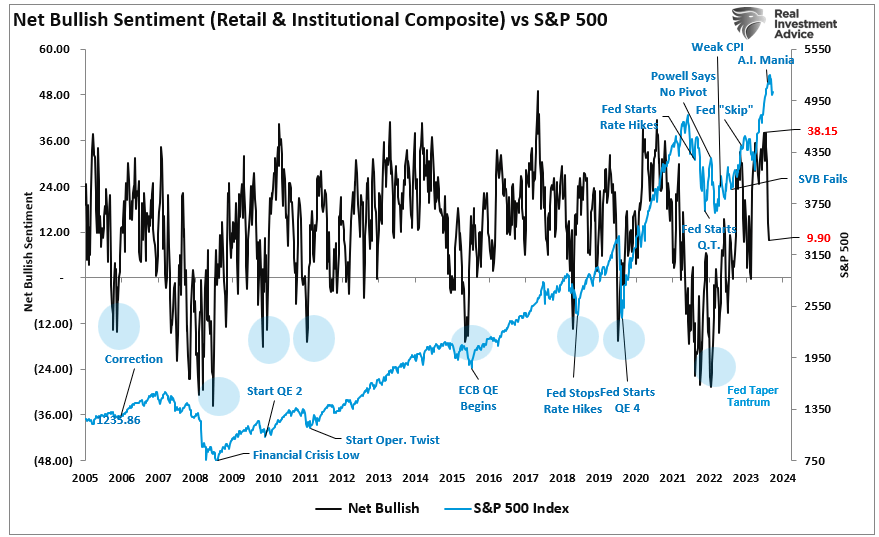
While the bullish sentiment index can indeed fall further, what is notable is the sharp reversal of market “exuberance” in such a short span. However, as discussed in “Just A Correction,” there was a significant gap between buyers and sellers.
“However, at some point, for whatever reason, this dynamic will change. Buyers will become more scarce as they refuse to pay a higher price. When sellers realize the change, they will rush to sell to a diminishing pool of buyers. Eventually, sellers will begin to “panic sell” as buyers evaporate and prices plunge.”
Like clockwork, that correction came quickly, with the market finding initial support at the 100-DMA. With solid earnings from GOOG and MSFT, the market rallied to initial resistance at the convergence of the 20- and 50-DMA. It would be unsurprising if the market failed this initial resistance test and ultimately retested the 100-DMA soon. Such a pullback would solidify that support and complete the reversal of the bullish sentiment index.

“Whatever trigger causes a reversal in the bullish signals, we will act accordingly to reduce risk and rebalance exposures. But one thing is sure: investor sentiment is extremely bullish, which has almost always been a good “bearish signal” to be more cautious.
While we have warned of a potential correction over the past few weeks, it reminds us much of June and July last year, where similar warnings for a 10% correction went unheeded. We are now seeing many individuals ‘jumping into the pool’ in some of the most speculative areas of the market. Such is usually a sign we are closer to a market peak than not. As such, we want to make adjustments before the correction comes.”
Very quickly, as supported by the bullish sentiment index, those bulls are turning bearish and are now calling for a more profound decline.
While such is possible, I suspect most of this correction is complete for two reasons.

Earnings Continue To Remain Strong
The first reason is that despite higher interest rates, earnings growth continues to remain robust, at least among the “Magnificent 7,” where Google (GOOG) and Microsoft (MSFT), in particular, exceeded estimates by a wide margin. However, overall, and most importantly, earnings growth has continued since the October lows of 2022. Notably, the support for improving earnings comes from the increased fiscal policies such as the Inflation Reduction Act and CHIPS Act.

While those policies will eventually fade, making forward estimates subject to downward revisions, the current earnings environment remains relatively robust. Furthermore, forward estimates remain optimistic that the Federal Reserve will cut rates later this year, lowering borrowing costs and supporting economic activity.

Notably, the increase in earnings, at least for now, remains a strong indicator of rising asset prices. The risk of a deeper market correction (greater than 10%) is significantly reduced during previous periods of improving earnings. While such does not mean a deeper correction can not happen, historically, corrections between 5% and 10% in an earnings growth environment tend to be buying opportunities and limit deeper reversal in the bullish sentiment index.
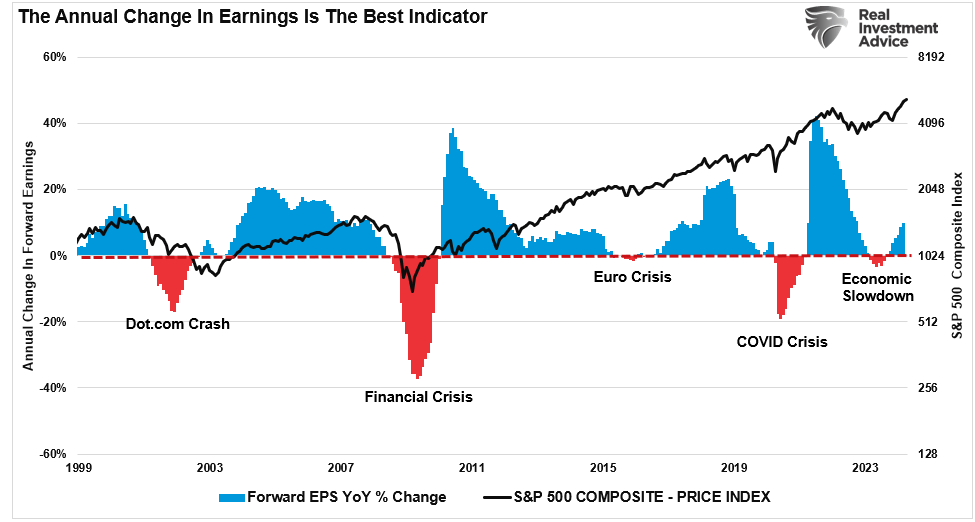
Improving earnings also precedes improving CEO confidence, which has provided pivotal support to financial markets since 2000.

Buybacks Returning
We discussed the most critical reason we expected a market correction in mid-March. To wit:
“Notably, since 2009, and accelerating starting in 2012, the percentage change in buybacks has far outstripped the increase in asset prices. As we will discuss, it is more than just a casual correlation, and the upcoming blackout window may be more critical to the rally than many think.” – March 19, 2024
Furthermore, the “blackout” of corporate buybacks coincided with more extreme readings in the bullish sentiment index. Buybacks are crucial to the market because corporations have accounted for roughly 100% of net equity purchases over the last two decades.

Here is the math of net flows if you don’t believe the chart:
- Pensions and Mutual Funds = (-$2.7 Trillion)
- Households and Foreign Investors = +$2.4 Trillion
- Sub Total = (-$0.3 T)
- Corporations (Buybacks) = $5.5T
- Net Total = $5.2 Trillion = Or 100% of all equities purchased
Unsurprisingly, that blackout window coincided with a sharp contraction of more than $367 billion in buybacks over the last 4-weeks. Consequently, when you remove a critical “buyer” from the market, the ensuing correction is unsurprising.
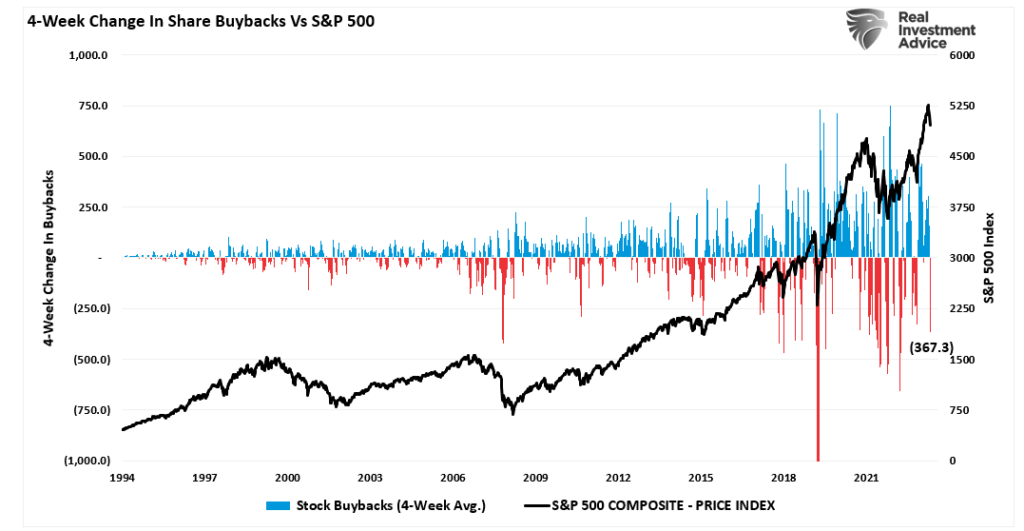
However, corporate share buybacks will resume in the next couple of weeks, and with more than $1 trillion slated for 2024, many buybacks remain to complete. Such is particularly the case with Google adding another $70 billion to that total.

As noted above, improving earnings and a decent outlook for the rest of this year also boost CEO confidence. (If you don’t understand why buybacks benefit insiders and not shareholders, read this.)
With robust economic activity supporting earnings growth, that improvement boosts CEO confidence. As CEOs are more confident about their business, they accelerate share buybacks to increase executive compensation.
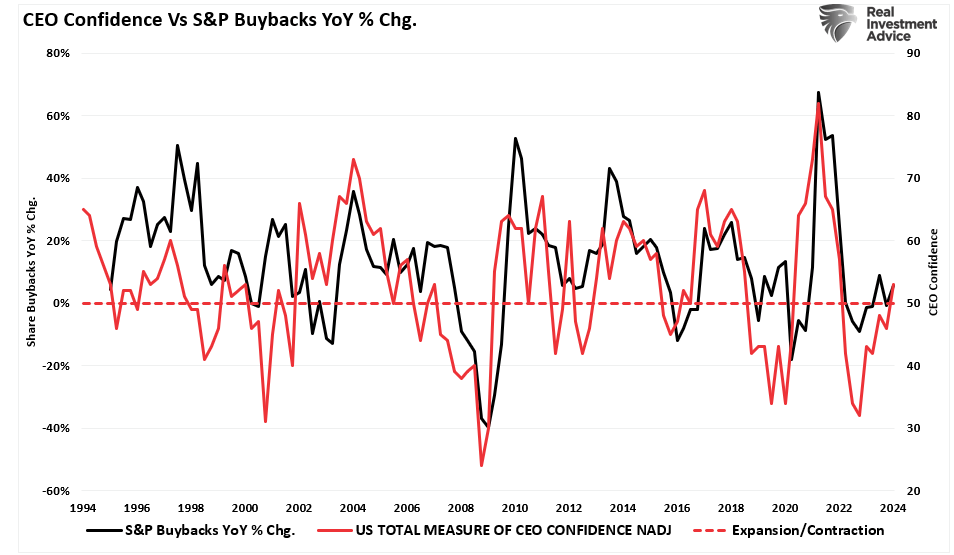
The liquidity boost from buybacks and stronger earnings will likely provide a floor below the market. This doesn’t mean the current correction doesn’t have more work to do. However, it is unlikely that it will resolve into something more significant.
At least for now.
The post Bullish Sentiment Index Reverses With Buybacks Resuming appeared first on RIA.
-
Site: Zero Hedge$3.5 Billion Slipped Into Ukraine-Israel Aid Bill To 'Supercharge Mass Migration From The Middle East'Tyler Durden Tue, 04/30/2024 - 05:45
Tucked away in the $95 billion military aid package for Ukraine, Israel and Taiwan is a $3.5 billion slush fund to open new processing centers for Muslim migrants, in what Sen. Eric Schmitt described as a bid to "supercharge mass migration from the Middle East."
 Muslims pray during the "Islam on Capitol Hill 2009" event at the West Front Lawn of the US Capitol September 25, 2009, in Washington, DC.
Muslims pray during the "Islam on Capitol Hill 2009" event at the West Front Lawn of the US Capitol September 25, 2009, in Washington, DC.
(Photo by Alex Wong/Getty Images)Not only did the “Foreign Aid” package do nothing to secure our own border it included $3.5 Billion to supercharge mass migration from the Middle East. https://t.co/bsbYapsaE2
— Eric Schmitt (@Eric_Schmitt) April 24, 2024And as Breitbart points out, the $95 billion package does not include any funds to help rebuild America's border defenses against illegal migration - but it does contain $481 million to settle migrants in US cities, and of course, the $3.5 billion to expand migration programs worldwide.
The $3.5 billion was granted to the Department of State, which works with many international groups that feed and transport migrants on their way to the United States.
Biden’s deputies are now using the refugee programs as an adjunct to their diversity-expanding “equity” migration policy. For example, Biden’s deputies used the program in March to import 3,009 migrants from the safe and democratic countries of El Salvador and Guatemala.
They are also using the refugee funds to expand migration routes from many African and Muslim countries. In March, they pulled in 12,018 people from the Congo, plus 16,732 migrants from the Muslim countries of Afghanistan, Syria, Pakistan, Iraq, and Eritrea, according to a report by Stacker.com. -Breitbart
Tucked into the folds of the new foreign aid package is $3.5 billion for mass immigration NGOs.
— Theo Wold (@RealTheoWold) April 25, 2024
America Last Republicans voted to supercharge mass immigration while approving ZERO $$ for the U.S. border.According to an April 23 release from the Biden DHS visa-granting agency, "The Biden-Harris administration set the refugee admissions ceiling for fiscal year 2024 at 125,000 refugees," adding "With the opening of the Doha Field Office on May 7, 2024, and the Ankara Field Office on May 9, 2024, USCIS will have 11 international field offices. Other international field offices include Beijing; Guangzhou, China; Guatemala City; Havana; Mexico City; Nairobi, Kenya; New Delhi; San Salvador, El Salvador; and Tegucigalpa, Honduras."
So - we have the US government encouraging migration, both legal and illegal - which hurts low-income Americans the most, while neglecting to the borders. Seems we've learned nothing from Europe.
-
Site: The Remnant Newspaper - Remnant Articles“Walter Matt's courageous decision to found The Remnant in the 1967 could, to all intents and purposes, be said to have given birth to the Traditionalist movement in the United States. In fact, I'd go so far as to say, were it not for Walter Matt, there would be NO Traditionalist movement in the United States.” - Michael Davies
-
Site: Crisis Magazine

Did spiritual beings help man develop the atomic bomb? Did they warn us in advance of 9/11 through Alex Jones? Tucker Carlson seems to think so, as he indicated while on Joe Rogan’s podcast recently. The three-hour conversation between the two media giants covered a whole host of topics, including the atomic bombing in Japan, the collapse of Building 7 on 9/11, and Richard Nixon’s resignation.
-
Site: Padre PeregrinoBefore looking at the Synod of Pistoia, let's define Archaeologism (also called antiquarianism.) Unam Sanctam defines it: Archaeologism is not so much a heresy as a fad, a certain approach to Catholic liturgy and practice. Its distinguishing characteristic is an excessive value placed on those Catholic practices which came earlier in historical-chronological succession. For the [...]
-
Site: Crisis Magazine

The April edition of Life Extension magazine contains an article called “The Death of Death,” subtitled “The Scientific Possibility of Physical Immortality and its Moral Defense.” To say that its “moral defense” lacks any teeth would be a laughable understatement. The article bears the same title as a book authored by Jose Cordeiro, Ph.D., and David Wood and comes in the form of an interview…
-
Site: Mundabor's blogCardinal Ravasi, who at 81 will, blessedly, not allowed to do damage at the next conclave, is on record with saying that Christ was “a layman”. It really is quite disconcerting with these idiots. I do not think this is age playing tricks with the man’s mind. In fact, Ravasi seems to be still quite […]
-
Site: AsiaNews.itToday's news: The Afghan Talibanlauncha nationwide anti-polio campaign;US court sentences Chinese student to prison for stalking threats against compatriot 'pro-democracy' campaigner;Casualties and new school closures due to heat wave in India and Bangladesh;Another two-year sentence for Thai activist in prison for lese majesty.
-
Site: AsiaNews.itKazakhstan is seeking more than $150 billion in foreign funding for the exploitation of fields on the Caspian. But Moscow does not fail to mention often that its northern territories are 'originally Russian' and Russian-speaking, as is claimed for the Donbass.
-
Site: 4Christum
Gloria TV News
Francis Praises Runaway Sister Who Was a Regime Artist
 On 28th April Francis became the first Pope to visit the Biennale, a cultural event in Venice, Italy, where the decadent Vatican presented the works of Corita Kent (+1986), an ex-nun from the United States.
On 28th April Francis became the first Pope to visit the Biennale, a cultural event in Venice, Italy, where the decadent Vatican presented the works of Corita Kent (+1986), an ex-nun from the United States.
Kent began as a Sister of the Immaculate Heart of Mary (IHM), taught for 30 years at the Immaculate Heart College in Los Angeles, but then styled herself as a "pop art nun". She left her order in 1968 and became a left-wing activist masquerading as an "artist".
Cardinal James McIntyre (+1979) of Los Angeles called Immaculate Heart College "communist" and Sister Corita's work "blasphemous". Immaculate Heart College was dissolved in 1981.
After Vatican II, the Sisters of the Immaculate Heart of Mary hired Carl Rogers, a "psychologist", to run "encounter groups" to share "real feelings". The IHM were among the first religious communities in the USA to implement Vatican II. The result was a disaster.
Then-Superior Anita Caspary left religious life with about 300 IHM sisters to form an independent sect which is now dying. The 68 sisters who did not follow her split into three smaller communities, two of which are about to close, and one, the Sisters of the Immaculate Heart of Mary in Wichita, Kansas, is thriving.
Corita Kent's serigraphs are heavily text-based, with scriptural passages and emotive quotes. One shows John XXIII after the Second Vatican Council with the slogan 'Let the sun shine in'. Another shows a rainbow and the word "love".
Today in Venice, Francis said that "joy and suffering come together in the feminine in a unique way", adding: "I think of artists like [the communist] Frida Khalo, [the blasphemous] Corita Kent and [the homosex-propagandist] Louise Bourgeois, and so many others. I sincerely hope that contemporary art can open our eyes and help us to appreciate the contribution of women as co-leaders of the human adventure". Khalo, Kent and Bourgeois were all closely associated with the regime and praised by the oligarchic media. -
Site: Voltaire NetworkThe comparison is shocking: the organization of the Olympic Games in Paris 2024 uses propaganda tricks from those of Berlin 1936. Yet it is nevertheless possible to explain: President Emmanuel Macron, like Chancellor Adolf Hitler, is pursuing the same "New European Order" project.. Unlike his predecessor, he is going about it peacefully, but like him, he will fail because, like him, he despises the people. What's more, his project is out-dated: it no longer corresponds to the structures of the digital age.

